inbox and environment news: Issue 552
August 28 - September 3, 2022: Issue 552
Friends Of Narrabeen Lagoon Catchment August Forum: Ku-Ring-Gai GeoRegion Project
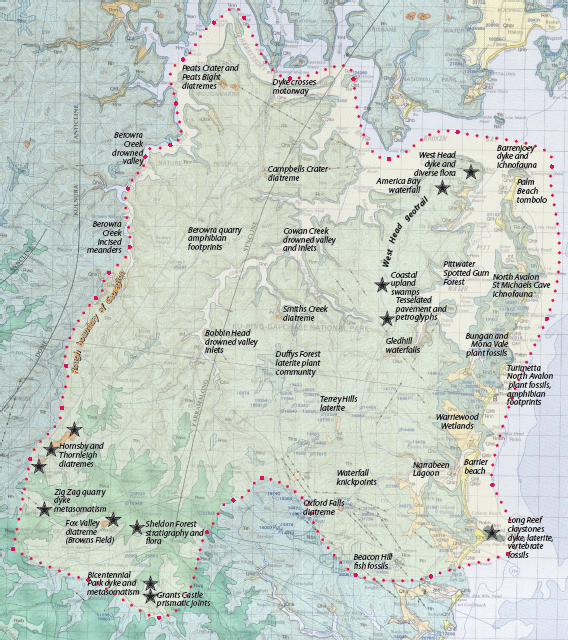
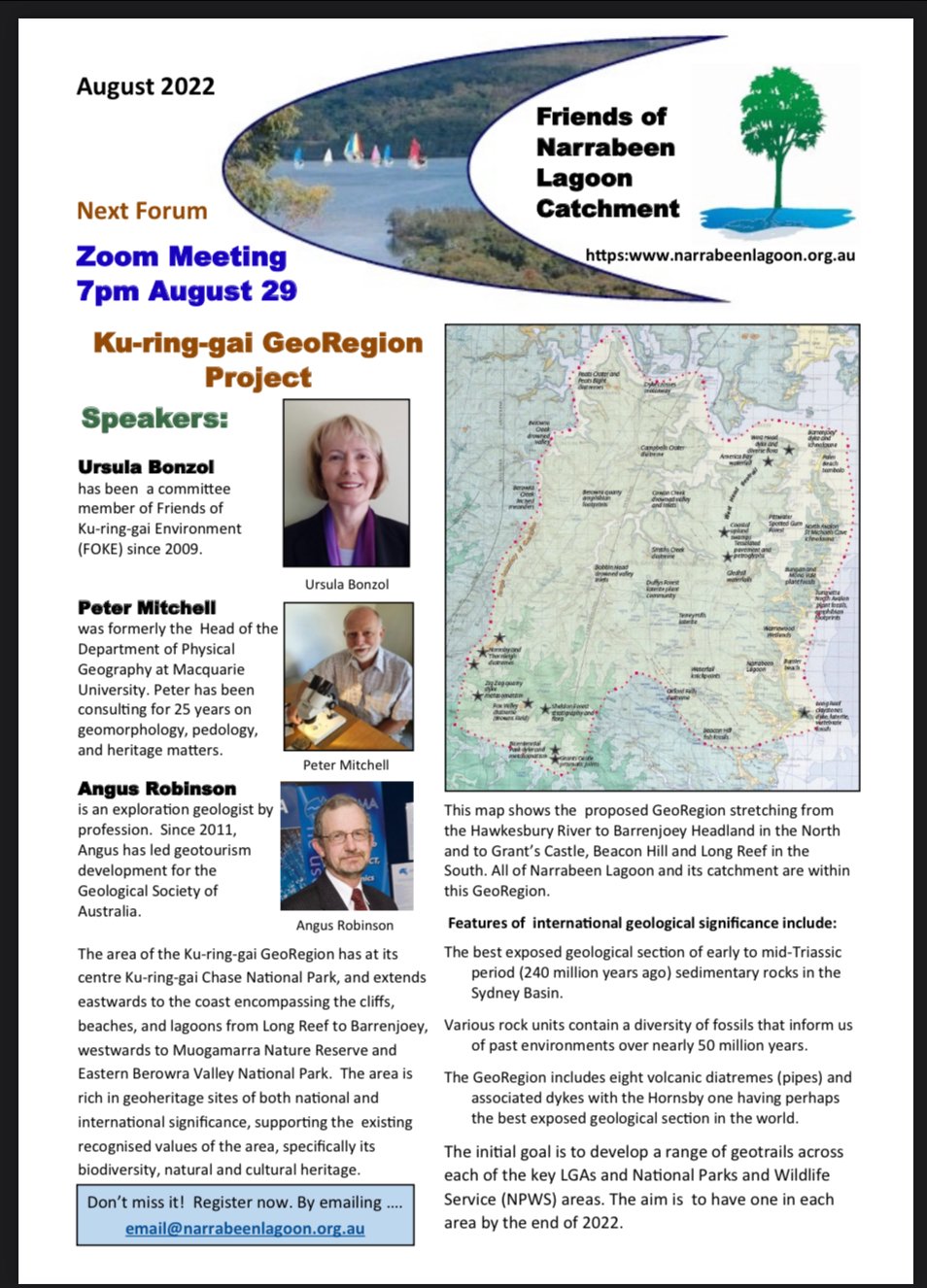
Warriewood Creeklines Works Delayed Due To Rains
So-Called Biodiversity Certificates Scheme Another False Solution To Tackling Environmental Crisis Researcher States
Biodiversity Certificates To Increase Native Habitat And Support Australian Landholders
Nap Nap Water Recovery Project Announced
- Access points for the Rural Fire Service.
- Provide economic benefits to the local economy through local purchasing and employment opportunities from the investment in the project.
- Increasing drought resilience and preparedness of Nap Nap Station.
- Improve the conditions for animals on the property improving both their wellbeing and health outcomes.
Measuring Benefits Of Blue Carbon Ecosystems
Planning Decisions For Aboriginal Communities: Two New Groups Formed By NSW Department Of Planning
Australian Teachers Want Support To Embrace Nature Play In Primary Education
- better mental health (98%)
- improved cognitive development (96%)
- learning about risk-taking (96%)
- spending time outdoors/in nature (96%).
- limited knowledge and confidence about how to incorporate into learning or how to operate the class outside (68%)
- a crowded curriculum restricted their ability to adopt new learning (64%)
- a lack of understanding/support from others in the school (38%).
Bringing Sea Horses And Kelp Forests Back To World's Most Iconic Harbour: Seabirds To Seascapes
- restoring Sydney Harbour's marine ecosystems by installing Living Seawalls, and replanting seagrass meadows and kelp forests
- supporting the future of little penguins in New South Wales by conducting the first ever statewide little penguin census to better understand their population size and how they're responding to threats such as climate change
- helping fur seals thrive as a species by conducting a seal survey to identify their preferred habitat, breeding grounds, diet and key threats.
Leopard Seal Visitor
.jpg?timestamp=1660590847423)
Echidna 'Love Train' Season Commences
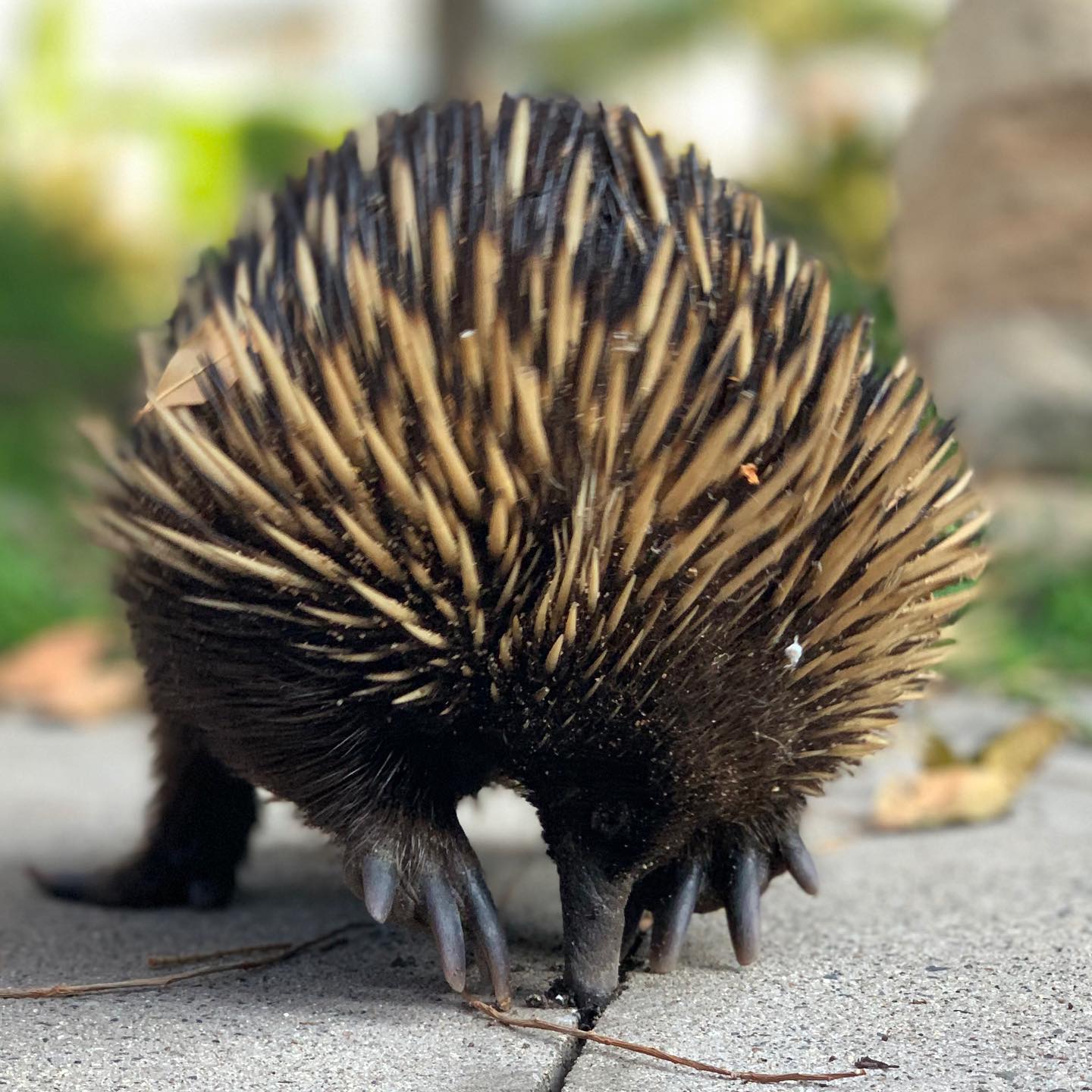
Dogs Off-Leash On Beaches Open For Feedback
- Do You Want Pittwater Leashed? Let The Council Know Why!
- Calls For Council To Address Dogs Offleash Everywhere After Two Serious Dog Attacks On Local Beaches In Same Week - owner has still not come forward or been identified as of Saturday August 6, 2022
- Sydney Dog Attack Victim Awarded $225, 000: July 2022
- Council Push For Dogs Off Leash On Family Beaches Among Wildlife Habitat
White faced heron landing at north Palm Beach, March 7th, 2022 during storm event. All native birds, reptiles, amphibians and mammals (except the dingo) are protected in New South Wales by the Biodiversity Conservation Act 2016 (BC Act).
Magpie Breeding Season: Avoid The Swoop!
- Try to avoid the area. Do not go back after being swooped. Australian magpies are very intelligent and have a great memory. They will target the same people if you persist on entering their nesting area.
- Be aware of where the bird is. Most will usually swoop from behind. They are much less likely to target you if they think they are being watched. Try drawing eyes on the back of a helmet or hat. You can also hold a long stick in the air to deter swooping.
- Keep calm and do not panic. Walk away quickly but do not run. Running seems to make birds swoop more. Be careful to keep a look out for swooping birds and if you are really concerned, place your folded arms above your head to protect your head and eyes.
- If you are on your bicycle or horse, dismount. Bicycles can irritate the birds and the major cause of accidents following an encounter with a swooping bird, is falling from a bicycle. Calmly walk your bike/horse out of the nesting territory.
- Never harass or provoke nesting birds. A harassed bird will distrust you and as they have a great memory this will ultimately make you a bigger target in future. Do not throw anything at a bird or nest, and never climb a tree and try to remove eggs or chicks.
- Teach children what to do. It is important that children understand and respect native birds. Educating them about the birds and what they can do to avoid being swooped will help them keep calm if they are targeted. Its important children learn to protect their face.
Wanted: Photos Of Flies Feeding On Frogs (For Frog Conservation)
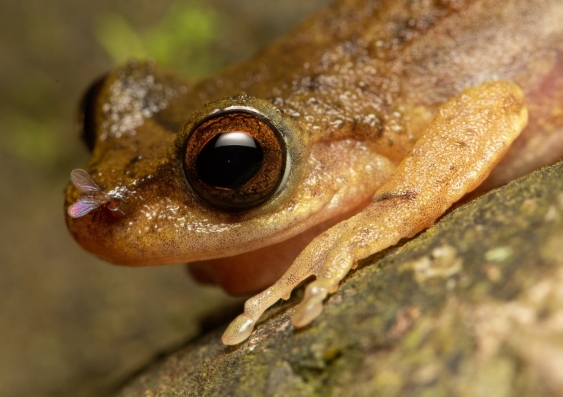
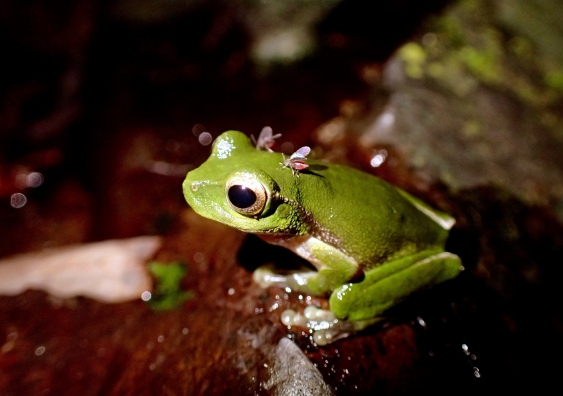
Possums In Your Roof?: Do The Right Thing

Local Wildlife Rescuers And Carers State That Ongoing Heavy Rains Are Tough For Us But Can Be Tougher For Our Wildlife:
- Birds and possums can be washed out of trees, or the tree comes down, nests can disintegrate or hollows fill with water
- Ground dwelling animals can be flooded out of their burrows or hiding places and they need to seek higher ground
- They are at risk crossing roads as people can't see them and sudden braking causes accidents
- The food may disappear - insects, seeds and pollens are washed away, nectar is diluted and animals can be starving
- They are vulnerable in open areas to predators, including our pets
- They can't dry out and may get hypothermia or pneumonia
- Animals may seek shelter in your home or garage.
You can help by:
- Keeping your pets indoors
- Assessing for wounds or parasites
- Putting out towels or shelters like boxes to provide a place to hide
- Drive to conditions and call a rescue group if you see an animal hit (or do a pouch check or get to a vet if you can stop)
- If you are concerned take a photo and talk to a rescue group or wildlife carer
There are 2 rescue groups in the Northern Beaches:
Sydney Wildlife: 9413 4300
WIRES: 1300 094 737
Please be patient as there could be a few enquiries regarding the wildlife.
Generally Sydney Wildlife do not recommend offering food but it may help in some cases. Please ensure you know what they generally eat and any offerings will not make them sick. You can read more on feeding wildlife here
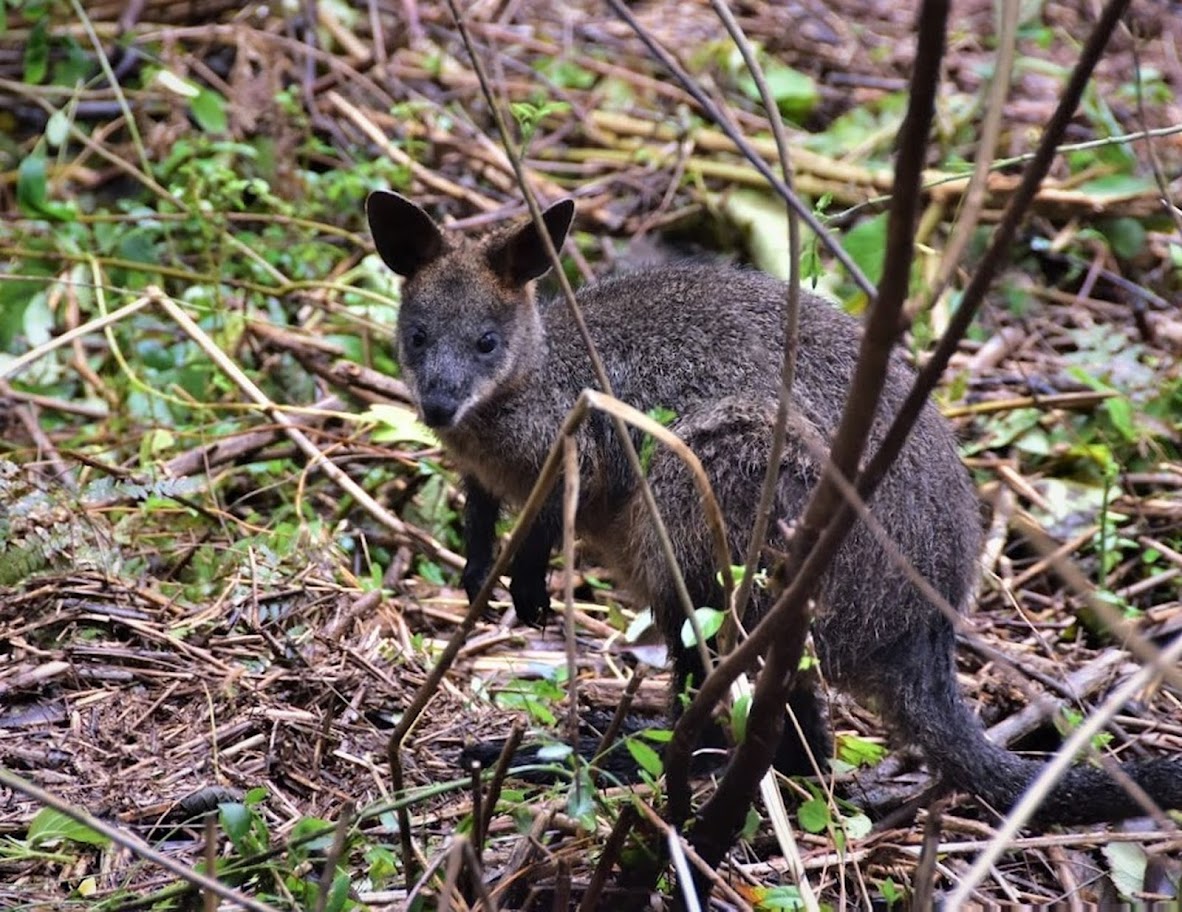
Information courtesy Ed Laginestra, Sydney Wildlife volunteer. Photo: Warriewood Wetlands Wallaby by Kevin Murray, March 2022.
Aviaries + Possum Release Sites Needed

Sydney Wildlife Rescue: Helpers Needed
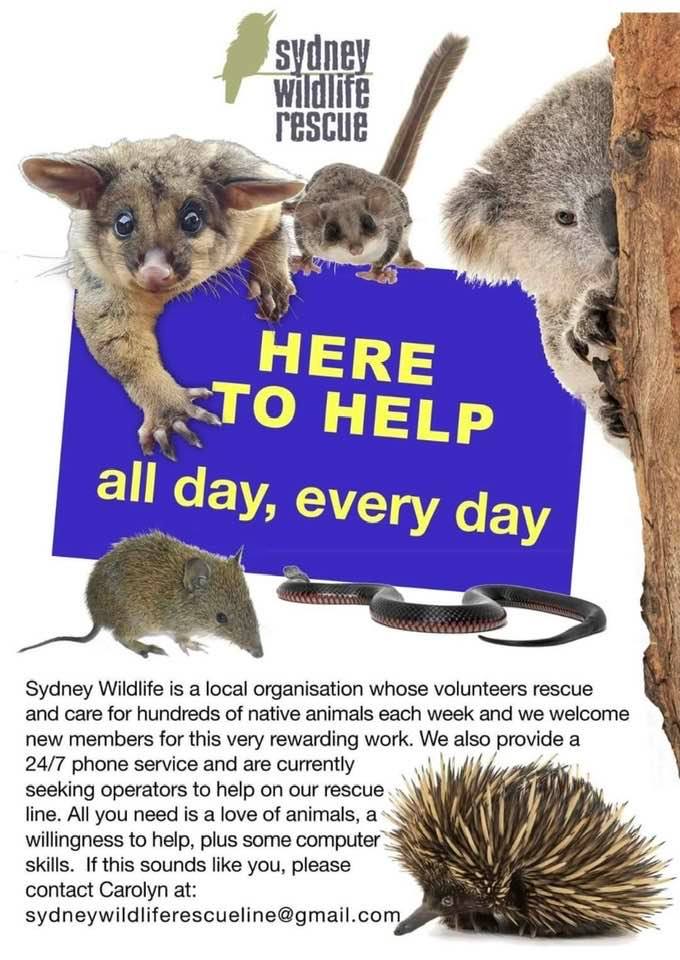
Bushcare In Pittwater
Where we work Which day What time
Avalon
Angophora Reserve 3rd Sunday 8:30 - 11:30am
Avalon Dunes 1st Sunday 8:30 - 11:30am
Avalon Golf Course 2nd Wednesday 3 - 5:30pm
Careel Creek 4th Saturday 8:30 - 11:30am
Toongari Reserve 3rd Saturday 9 - 12noon (8 - 11am in summer)
Bangalley Headland 2nd Sunday 9 to 12noon
Bayview
Winnererremy Bay 4th Sunday 9 to 12noon
Bilgola
North Bilgola Beach 3rd Monday 9 - 12noon
Algona Reserve 1st Saturday 9 - 12noon
Plateau Park 1st Friday 8:30 - 11:30am
Church Point
Browns Bay Reserve 1st Tuesday 9 - 12noon
McCarrs Creek Reserve Contact Bushcare Officer To be confirmed
Clareville
Old Wharf Reserve 3rd Saturday 8 - 11am
Elanora
Kundibah Reserve 4th Sunday 8:30 - 11:30am
 Mona Vale
Mona Vale Mona Vale Beach Basin 1st Saturday 8 - 11am
Mona Vale Dunes 2nd Saturday +3rd Thursday 8:30 - 11:30am
Newport
Bungan Beach 4th Sunday 9 - 12noon
Crescent Reserve 3rd Sunday 9 - 12noon
North Newport Beach 4th Saturday 8:30 - 11:30am
Porter Reserve 2nd Saturday 8 - 11am
North Narrabeen
Irrawong Reserve 2nd Saturday 2 - 5pm
Palm Beach
North Palm Beach Dunes 3rd Saturday 9 - 12noon
Scotland Island
Catherine Park 2nd Sunday 10 - 12:30pm
Elizabeth Park 1st Saturday 9 - 12noon
Pathilda Reserve 3rd Saturday 9 - 12noon
Warriewood
Warriewood Wetlands 1st Sunday 8:30 - 11:30am
Whale Beach
Norma Park 1st Friday 9 - 12noon
Western Foreshores
Coopers Point, Elvina Bay 2nd Sunday 10 - 1pm
Rocky Point, Elvina Bay 1st Monday 9 - 12noon
Gardens And Environment Groups And Organisations In Pittwater
Opening 10 new oil and gas sites is a win for fossil fuel companies – but a staggering loss for the rest of Australia

Federal Resources Minister Madeleine King yesterday handed Australia’s fossil fuel industry two significant wins.
The minister announced oil and gas exploration will be allowed at ten new Australian ocean sites – comprising almost 47,000 square kilometres. And she approved two new offshore greenhouse gas storage areas off Western Australia and the Northern Territory, to explore the potential of “carbon capture and storage” (CCS) technology.
The minister said the new oil and gas permits will bolster energy security in Australia and beyond, and ultimately aid the transition to renewables. King also said controversial carbon-capture and storage was necessary to meet Australia’s net-zero emissions targets.
The world’s energy market is going through a period of disruption, largely due to Russian sanctions and the Ukrainian war. But expanding carbon-intensive fossil fuel projects is flawed reasoning that will lead to greater global insecurity.
Research shows 90% of coal and 60% of oil and gas reserves must stay in the ground if we’re to have half a chance of limiting global warming to 1.5℃ this century.
Ignoring The Facts
The new sites for offshore gas and oil exploration comprise ten areas off the coasts of the NT, WA, Victoria, and the Ashmore and Cartier Islands. King’s announcement came at a resources conference in Darwin, where she said:
Gas enables greater use of renewables domestically by providing energy security. Australian [liquefied natural gas] is also a force for regional energy security and helps our trading partners meet their own decarbonisation goals.
The problem with this assessment is that it ignores two things.
First, Australia exports nearly 90% of domestically produced gas and lacks robust export controls to moderate this. Without these controls, increasing domestic production will not improve Australia’s energy security.
Second, gas can only enable greater use of renewables domestically and provide energy security where it is “decarbonised” through the use of carbon-capture and storage. If it isn’t decarbonised, using gas undermines energy security by risking further global warming.
However the deployment of CCS technology is complex, expensive and faces many barriers. To date it has a history of over-promising and under-delivering.
Carbon-capture and storage typically involves capturing carbon dioxide at the source (such as a coal-fired power station), sending it to a remote location and storing it underground.
Offshore CCS involves injecting and storing CO₂ in suitable rock formations. Doing so safely requires robust monitoring and verification, but challenging ocean conditions can make this extremely difficult.
For example, Chevron allegedly failed to capture and store CO₂ at its huge offshore Gorgon gas project, after the WA government approved the project on the condition the company sequester 80% of the project’s emissions in its first five years.
A report in February suggested the project emitted 16 million tonnes more than anticipated due to injection failure. King calls CCS a “proven” technology, but Chevron’s experience indicates this is far from the case.
King did say the federal government won’t rely entirely on CCS, adding “it’s one of the many means of getting to net-zero” and renewable energy remained central to Australia’s emissions reduction efforts.
But critics labelled the technology a “smokescreen” behind which fossil fuel companies can continue to pollute.
Fossil Fuels Are Not The Future
Putting gas in competition with renewable energy will end badly for the fossil fuel industry. As renewable energy’s market share expands, fossil fuels will become uneconomic due to their environmental impacts and higher costs.
Eventually, natural gas will be used only during periods of peak demand or when wind and solar are not producing electricity – in other words, when the sun isn’t shining and the wind isn’t blowing. It will not provide the steady, constant electricity supply that makes up our baseload power system. This reality will significantly reduce gas demand and negate the need for carbon-capture and storage.
Opening up new gas and oil exploration is a reactive and dangerous move that does not support Australia’s long-term energy future. Many of our international peers already acknowledge this.
The United Kingdom, for example, now generates 33% of its electricity from renewable sources such as onshore and offshore wind, solar and biomass. The subsequent decline of fossil fuels means the UK has reduced its greenhouse gas emissions by more than 50% on 1990 levels.
Gas in the UK is valuable for its ability to provide rapid, flexible power supply during peak periods, to integrate with other renewable technologies and to improve system flexibility. During periods of high demand, storage devices can discharge into the grid and maintain security of supply.
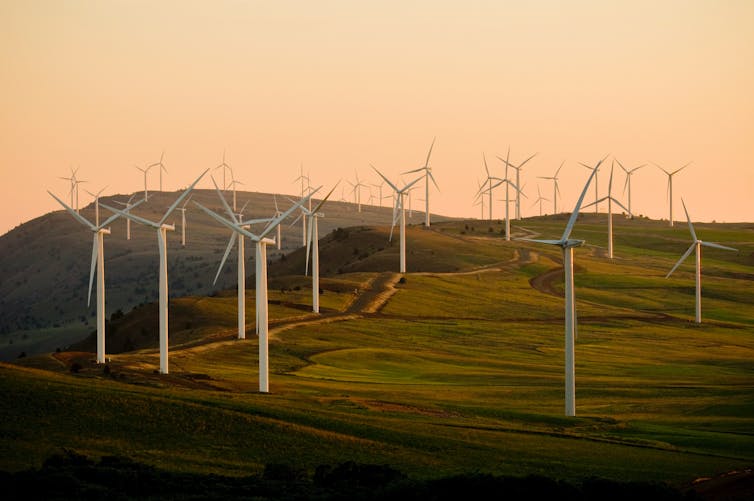
Wrong Way, Go Back
Clearly, Australia is heading in the wrong direction by opening up new fossil fuel exploration.
The move will damage our longer-term security and undermine our climate imperatives. It ignores the glaring economic realities that will eventually push gas out of the market.
And opening new gas fields while carbon-capture remains uncertain is dangerous for the planet. ![]()
Samantha Hepburn, Professor, Deakin Law School, Deakin University
This article is republished from The Conversation under a Creative Commons license. Read the original article.
Suspected Poisoning Of Shoalhaven Flying-Foxes
South32 Cancels Water-Draining Dendrobium Coal Mine Expansion Plan
Newly Discovered Legless Lizard To Be Considered In Final IPC Decision On Mount Pleasant Coal Mine
In a letter dated 12 August 2022, the Department wrote to the IPC, advising that:
‘MACH Energy Australia Pty Ltd (MACH) [the applicant for the Project] has provided the Department with a research paper … confirming that the Legless Lizard recorded at Mount Pleasant is not the Striped Legless Lizard (Delma impar) as previously thought, but is in fact a new species not previously identified. Importantly, this species is not yet listed as threatened under the Biodiversity Conservation Act 2016 (BC Act).’
The Panel has since heard from stakeholders in relation to this issue and has revised its position of 19 August 2022. The Panel considers that it would be assisted by public submissions on the DPE letter and its attachments regarding the identification of the Legless Lizard, linked here.Public submissions may be made only on this new material and must be received via email (ipcn@ipcn.nsw.gov.au) by 5pm AEST Tuesday, 30 August 2022.
Santos Wants To Dump 61,500 Bull Elephants Worth Of Coal Seam Gas Waste In Western Sydney Or The Headwaters Of The Murray-Darling
- WeKando, Chinchilla, Queensland (on the banks of a tributary of the Murray-Darling)
- A landfill facility at Kemps Creek in Western Sydney
- A landfill facility at Jackson, Queensland (500km from Narrabri)
Chlamydia Vaccine Trial For Koalas In South-West Sydney
Climate Change Predicted To Reduce Kelp Forests' Capacity To Trap And Store Carbon
.jpg?timestamp=1661476788801)
It’ll be impossible to replace fossil fuels with renewables by 2050, unless we cut our energy consumption
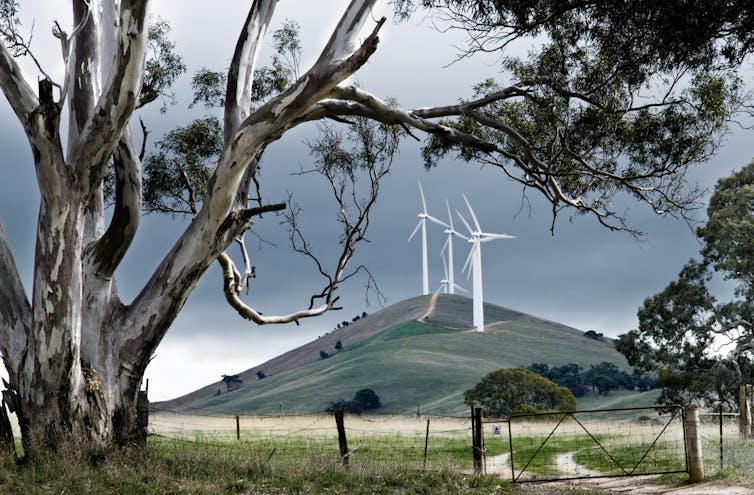
Energy consumption – whether its heating your home, driving, oil refining or liquefying natural gas – is responsible for around 82% of Australia’s greenhouse gas emissions.
Unless Australia reduces its energy consumption, my recent study finds it’ll be almost impossible for renewable energy to replace fossil fuels by 2050. This is what’s required to reach our net-zero emissions target.
Yet, as the nation’s economy recovers from the pandemic, Australia’s energy consumption is likely to return to its pre-pandemic growth. The study identifies two principal justifications for reducing energy consumption (or “energy descent”):
- the likely slow rate of electrifying transport and heating
- that renewable energy will be chasing a retreating target if energy consumption grows.
Energy descent isn’t an impossible task. Indeed, in 1979, Australia’s total final energy consumption was about half that in 2021. Key to success will be transitioning to an ecologically sustainable, steady-state economy, with greener technologies and industries.
What’s Slowing Down Growth In Renewables?
To transition to sustainable energy, Australia must electrify transport and combustion heating, while replacing all fossil-fuelled electricity with energy efficiency and renewables, which are the cheapest energy technologies.
Renewables can be rolled out rapidly: wind and solar farms can be built in just a few years and residential rooftop solar can be installed in a single day.
But rapid growth in wind and solar is slowed by three critical infrastructural and institutional requirements of the electricity industry:
- to establish Renewable Energy Zones (a cluster of wind and solar farms and storage)
- to build new transmission lines and medium-term energy storage such as pumped hydro
- to reform electricity market rules to make them more suitable for renewable electricity.
These take longer than building solar and wind farms and much longer than installing rooftop solar and batteries. Nevertheless, they could be fully implemented within a decade.
In fact, transitioning existing fossil-fuelled electricity generation, such as coal-fired power stations, to 100% renewables could possibly be completed by the early 2030s.
But optimistic calculations based on how quickly we can build solar and wind farms and their infrastructure ignore the fact that the growth of renewable electricity is limited by electricity demand.
When existing coal-fired power stations have been replaced by renewables, electricity demand will be determined by how rapidly we can electrify transport and combustion heating. These are the principal tasks that will limit the future growth rate of renewable electricity. They will likely be implemented slowly, despite the urgency of climate change.
Households and industries have big investments in petrol/diesel vehicles and combustion heating. They may be reluctant to replace these working technologies, without substantial government incentives.
So far, effective federal government policies are almost non-existent for transitioning transport and heating, which are together responsible for 38% of Australia’s emissions.
This month’s announcement of a future “consultation” on fleet fuel efficiency standards is the government’s tentative first step.
Chasing A Retreating Target
If we look at only percentage growth rates, the task of renewable electricity looks misleadingly easy. From 2015 to 2019, Australia’s renewable electricity grew by 62% – an excellent achievement.
But, it was starting from a small base. This means its increase in energy production over that period was only slightly bigger than the growth of total final energy consumption – comprising electricity, transport and heating – which is still mostly fossil fuelled.
On the global scale, the situation is even worse. As a result of growth in total final energy consumption, the share of fossil fuels was the same in 2019 as in 2000: namely around 80%.
The challenge for renewable energy is like a runner trying to break a record while officials are striding away down the track with the finishing tape.
This situation is not the fault of renewable energy technologies. Nuclear energy, for example, would grow much more slowly and would take even longer to catch up with growing consumption.
In one of the scenarios I explore in my study, Australia’s total final energy consumption grows linearly at the pre-pandemic rate from 2021 to 2050. Then, renewable electricity would have to grow at 7.6 times its pre-pandemic rate to catch up by 2050.
Alternatively, if renewable electricity growth is exponential, it would have to double every 6.8 years until 2050.
Considering that future growth in renewable electricity will be limited by the rate of electrifying transport and combustion heating, both the required linear and exponential growth rates appear impossible.
Possible Solutions
Both the International Energy Agency and modelling done for the Intergovernmental Panel on Climate Change avoid the problem by assuming large-scale carbon dioxide capture and storage or directly capturing CO₂ from the air will become commercially available.
But relying on these unproven technologies is speculative and risky. Therefore, we need a Plan B: reducing our energy consumption.
My study shows if we could halve 2021 energy consumption by 2050, the transition may be possible. That is, if raw materials (such as lithium and other critical minerals) are available and local manufacturing could be greatly increased.
For example, if the total final energy consumption declines linearly and renewable electricity grows linearly, the latter would only have to grow at about three times its 2015–2019 rate to replace all fossil energy by 2050. For exponential growth, the doubling time is 9.4 years.
Improvements in energy efficiency would help, such as home insulation, efficient electrical appliances, and solar and heat pump hot water systems. However, the International Energy Agency shows such improvements will be unlikely to reduce demand sufficiently.
We need behavioural changes encouraged by socioeconomic policies, as well as technical.
Implications Of Energy Descent
To reduce our energy consumption, we would need public debate followed by policies to encourage greener technologies and industries, and to make socioeconomic changes.
This need not involve deprivation of key technologies, but rather a planned reduction to a sustainable level of prosperity.
It would be characterised by greater emphasis on improving and expanding public transport, bicycle paths, pedestrian areas, parks and national parks, public health centres, public education, and public housing.
This approach of providing universal basic services reduces the need for high incomes and its associated high consumption. As research in 2020 pointed out, the world’s wealthiest 40 million people are responsible for 14% of lifestyle-related greenhouse gas emissions.
And on a global scale, energy descent could be financed by the rich countries, including Australia. Most people would experience a better quality of life. Energy descent is a key part of the pathway to an ecologically sustainable, socially just society.![]()
Mark Diesendorf, Honorary Associate Professor, UNSW Sydney
This article is republished from The Conversation under a Creative Commons license. Read the original article.
10 images show just how attractive Australian shopping strips can be without cars

Think of a typical Australian shopping street: parked cars occupy the prime public space in front of the shops. But we could instead create a place that’s good for business and is beautiful too. It would attract customers while being good for our physical, mental and social health.
This isn’t a new idea. Realising they can make better use of the space next to businesses to boost sales, shopping centres design places to attract people. That’s why they provide seats, air-conditioning, music, artwork, cafes and plants outside their shops.
Online shopping is even comfier, but it lacks human contact.
We know what works to create people-friendly local shopping streets. Safer speeds, improving lighting, replacing parking with “parklets”, planting street trees and widening pavements — these are just some of the ways.
Below we’ll discuss four reasons to reallocate parking space next to shops. But first, we’ve re-imagined ten car-centric Australian streets to illustrate the benefits of reallocating space to people … to shoppers, diners, riders, children, prams and the mobility-impaired.
Transforming 10 Car-Centric Shopping Streets
These re-imagined streets show thriving liveable communities, supporting friends and families to meet, creating local jobs and providing access to fresh food. (Click on and move the sliders to compare the actual and re-imagined streets.)
1. Chapel Street, Windsor, Melbourne, Victoria
2. Beaumont Street, Hamilton, Newcastle, New South Wales
3. Darby Street, Newcastle, Newcastle, NSW
4. Hall Street, Bondi, Sydney, NSW
5. Princes Highway, Woonona, Wollongong, NSW
6. Belvidere Street, Belmont, Perth, Western Australia
7. Oxford Street, Leederville, Perth, WA
8a. Parklet, South Terrace, Fremantle, Perth, WA
8b. South Terrace, Fremantle, Perth, WA
9. Musk Avenue, Kelvin Grove, Brisbane, Queensland
The Elephant In The Room
Typically a car transports just one or two customers. A parked car occupies about 13 square metres. That’s about the size of an elephant lying down.
In the same space, 20 shoppers can be walking, 12 diners can sit outside a cafe, or 12 customers can park their bikes.
Before re-imagining the streets, we calculated that car parking (27%) and travel lanes (46%) took up nearly three-quarters of the street space, comparable to other research.
Reducing car parking and travel lanes allowed us to increase green space (up 18%), seating (up 17%) and footpaths (up 6%) in our re-imagined streets.
Creating beautiful and healthy shopping streets that provide safe and equitable access is key to attracting more business.
Encouraging motorists to park on neighbouring side streets or in off-street car parks can free up space for people. In any case, motorists rarely find parking right out the front of a shop — the (rising) number and size of cars makes that impossible.

4 Reasons To Redesign Shopping Streets
1: Local businesses benefit
Just this week, Perth’s lord mayor proposed ripping out a pedestrian mall in the CBD and opening it to cars. But this logic doesn’t stack up to get more customers.
It’s important to remember: cars don’t buy things from shops, people do. Shopping streets that prioritise people and beauty over cars will attract higher sales, higher retail rental values and reduced shop vacancy rates.
But where will shoppers park? Shoppers are already used to walking short distances from parking on side streets and in off-street car parks.
Switching to other modes of transport for short journeys to the shops is another option.
2. More attractive for COVID-19 dining
We now know that COVID-19 is airborne — meaning we can inhale the virus. Improving ventilation is key to reducing the spread, but this can be a challenge indoors.
The evidence suggests gathering outdoors is safer than indoors.
Almost half of Australians have a family dog, so being able to have a coffee outside opens up further business benefits of outdoor dining space.
Trialling more people-friendly streets can be a great way to demonstrate their benefits. NSW has already run trials of “streets as shared spaces” encouraging outdoor dining.
3: For kids and families
Great streets are enjoyable and safe places for kids and their families. Streets like this make it easier to get active and have fun.
We should listen to kids’ ideas when it comes to building healthy streets — they want their local streets to be active and fun places to meet their friends.
Shopping streets should make everyone feel welcome. By this we mean streets that:
- are safe and easy to cross
- have shade and shelter
- provide rest stops and benches
- are quiet, walkable and rideable
- have interesting things to see and do
- are relaxing
- have fresh, clean air.
4: Boost our physical activity and mental health
More than half of city car journeys are shorter than 5km — and many are even shorter. Ongoing under-investment in safe walking and cycling means Australians feel forced into driving short distances, even though they might prefer to walk or cycle.
Increasing walking is a cost-effective investment to boost Australia’s physical activity levels. It would reduce the one in ten deaths and A$15.6 billion-a-year burden of inactivity.
Riding or walking to the shops can be a relaxing and enjoyable experience, and shopping streets can be destinations that people enjoy walking around, staying a while and spending more.
When Australians have better access to local destinations, they walk more.
More people on the streets builds a sense of community, essential for optimal mental health.
Take-Home Message
For shopping streets to compete with larger shopping centres, they need to be more beautiful places to visit, which provide safe and inclusive access for people to spend money locally.
Towns and cities around the world are realising this. Tens of thousands of on-street car parking spaces are being reallocated to people, including in Auckland, Stockholm, Paris, Amsterdam, Milan. Australia can learn from their successes.
The authors encourage the open access reuse of the re-imagined streets. They are freely available to download in multiple formats.![]()
Matthew Mclaughlin, Research Fellow, Telethon Kids Institute, The University of Western Australia; Hayley Christian, Associate Professor, School of Population and Global Health, The University of Western Australia; Jasper Schipperijn, Professor of Active Living Environment, University of Southern Denmark, and Trevor Shilton, Adjunct Professor, School of Public Health, Curtin University
This article is republished from The Conversation under a Creative Commons license. Read the original article.
‘I will miss them if they are gone’: stingrays are underrated sharks we don’t know enough about

Am I not pretty enough? This article is part of The Conversation’s series introducing you to unloved Australian animals that need our help.
Have you ever done the “stingray shuffle”? If you live by the coast, you’ve probably taken this precaution to frighten off any buried stingrays as you wade into the water. Breath easy – your chances of getting stuck with a nasty barb are slim.
Any thoughts we have about stingrays usually end once danger is averted, but these fascinating creatures are much more than an inconvenience for beachgoers.
Stingrays are flat-bodied sharks that live in almost all marine environments worldwide. In fact, there are over 600 recognised species – most of which we know very little about. Even in the research world, we struggle to answer simple questions such as: which areas are most valuable for stingray populations and why?
The mangrove whipray (Urogymnus granulatus) is one such species. Aptly named, mangrove whiprays feel at home gliding through submerged mangrove roots in the tropical coastal regions of the Indo-Pacific and Northeast Australia. Unfortunately, they are at risk of decline and localised extinctions.
As a scientist who studies them, I attest these rather ordinary, mud-covered stingrays are beautiful, and I never tire of watching them. We have to ask ourselves: would it make any difference if these rays were here or not? How relevant are they for ecosystem health?
The Situation At Hand
Sharks and rays are experiencing some of the most drastic declines of any animal group inhabiting our oceans today due to fishing pressure and habitat loss, and coastal species are particularly vulnerable.
Stingrays are occasionally preyed upon by their toothy relatives, such as formidable Carcharhinid or hammerhead sharks. However, the shark-eat-shark world isn’t all to blame for losses of abundance and species becoming red-listed.
Most stingrays depend on shallow tidal habitats for feeding and protection, especially during their first years of life, but many of these areas worldwide are being lost and degraded. This is a big threat to the survival of mangrove whiprays.

Coastal development is a major contributor to the destruction of mangroves as we replace these seaside forests with marinas, agricultural land, factory ports, ocean-view hotels, homes, and other structures.
A recent global assessment of tidal wetlands found that compared to other coastal environment types, mangroves experienced some of the greatest losses due to human activities, with 3,700 square kilometres lost worldwide between 1999-2019.
Worsening drought conditions due to climate change may also threaten mangrove forests. For example, recent research suggests climate change contributed to the deaths of 40 million Northern Australian mangroves in the summer of 2015 and 2016.
We can only expect that with the loss of pristine mangrove environments, mangrove whiprays will diminish along with them. As this threat continues into the future, this little stingray remains at risk.
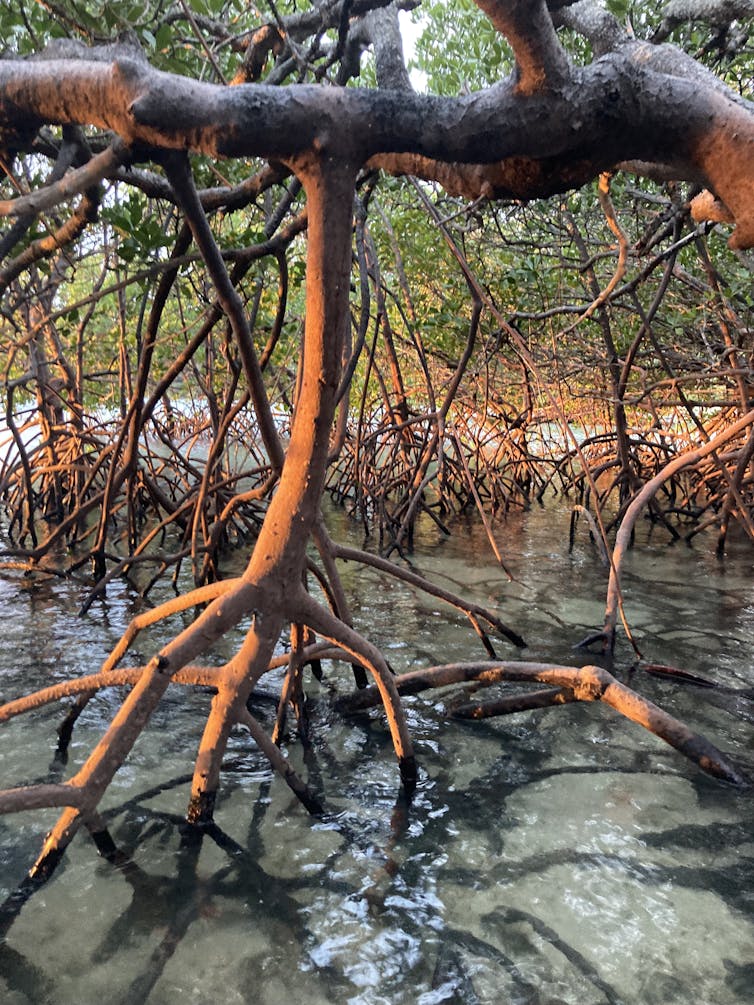
Why They Matter
Mangrove whiprays do much more than lay buried in the sand. While they’re not high profile apex predators, they fill an important niche as intermediate predators. Essentially, they are the glue that connects higher and lower levels of the food chain.
Since they’re usually seen from above, it’s hard to notice the small, suction-like mouth underneath, which they use to extract buried invertebrate prey. Combined with vigorous flapping of their winged pectoral fins, their feeding can stir up hefty clouds of sediment.
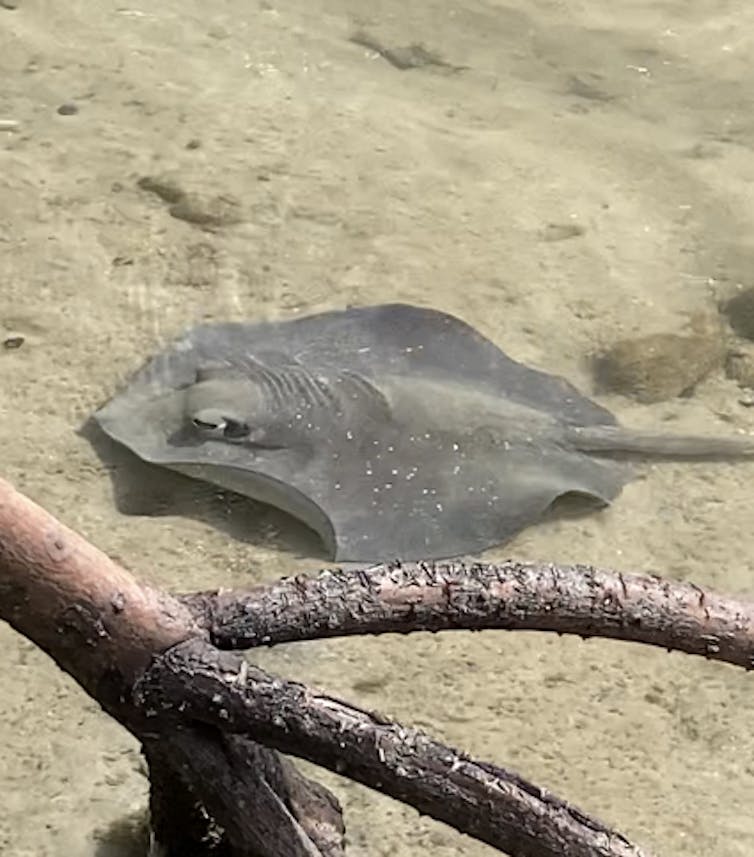
Through this intense excavation, they recirculate buried nutrients and small food items back into the water column. This, in turn, can be important for creating feeding opportunities for other organisms. My personal observations of foraging mangrove whiprays have revealed that small fishes often linger nearby to snack on stray food particles.
As both predator and prey, these rays also help transfer nutrients beyond where they feed across a broader range of ecosystems. This can occur at small scales when they creep in and out of intertidal areas with the tide and at larger scales when juveniles transition to deeper waters as adults.
This strengthens ecosystem connectivity, which is a critical component of overall health and stability of coastal environments.

So, under the category “ecosystem functions”, coastal stingrays like the mangrove whipray have an impressive resume worthy of our attention. The next big question regarding their conservation is: what can we do for them?
What We Can Do
Realistically, we cannot snap our fingers and stop all human activities from threatening the coastal mangroves they call home. What we can do is achieve a better understanding of where they are highly abundant and why, so we can identify pieces of critical habitat.
This way, conservation efforts can be designed to protect the areas they rely on the most.
An improved understanding on how mangrove whiprays participate in coastal food chains would also help us determine if declining populations threaten the welfare of coastal mangrove forests.
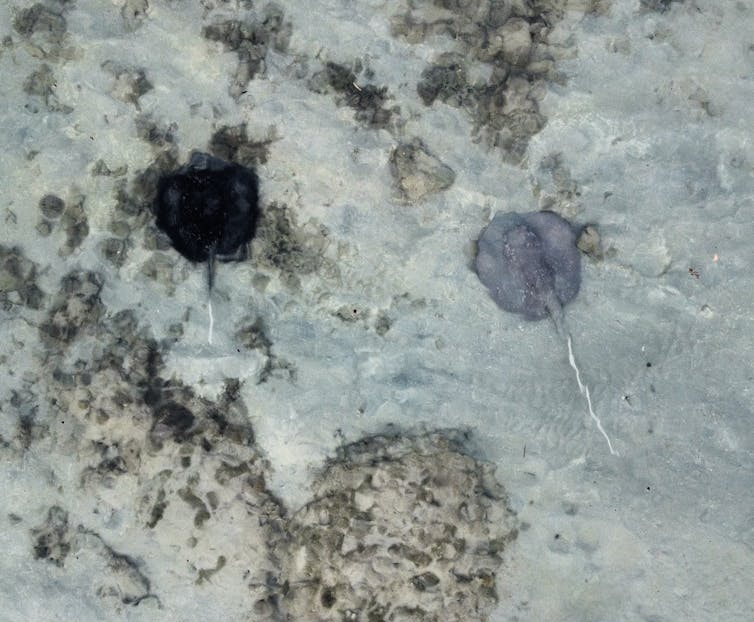
But the campaign for action doesn’t stop at mangrove whiprays. This species represents just one of many creeping into the bubble of conservation concern, and more may join the list if we continue without vital knowledge that can support their protection.
Examples of other vulnerable species that have been documented sharing habitats with mangrove whiprays are the pink whipray (Pateobatus fai) and giant guitarfish (Glaucostegus typus). Therefore, in areas where these different ray species live together, conservation strategies for one may have positive outcomes for all.
It’s up to scientists to fill the existing gaps on stingray ecology, but the average bystander can also help by spreading awareness for stingrays so their plight won’t drag on without any media headlines to lament it.
They may not warm our hearts with their cuddly cuteness (me excluded), but the wellbeing of our coastal ecosystems may just depend on these remarkable flat-bodied sharks. I know I will miss them if they are gone.![]()
Jaelen Nicole Myers, PhD Candidate, James Cook University
This article is republished from The Conversation under a Creative Commons license. Read the original article.
The road to new fuel efficiency rules is filled with potholes. Here’s how Australia can avoid them

Last week, federal Climate and Energy Minister Chris Bowen officially put fuel efficiency standards on the national agenda, saying the measure would reduce transport emissions and encourage electric vehicle uptake.
Fuel efficiency standards are applied to car manufacturers and indirectly set limits on how much CO₂ can on average be emitted from a new vehicle. Such standards lead to lower fuel costs for motorists and could help Australia meet its targets under the Paris climate agreement.
Importantly, Bowen noted any new rules must be ambitious and designed specifically for Australia. But implementing effective standards is easier said than done – and there are many potholes to avoid.
Without a robust set of mandatory transport emissions standards, Australia’s dependence on fossil fuels will deepen, and reaching our emissions reduction goals will become harder.

Standards Must Be Mandatory
Road vehicles vary in the efficiency with which they use fossil fuels such as petrol and diesel. For example, large SUVs are usually less fuel efficient than smaller, lighter cars. And of course, electric vehicles operate without any fossil fuels at all (although the energy source used to charge their batteries determines how “green” they are).
Stringent fuel efficiency standards will encourage the auto industry to bring more electric vehicles to Australia, and reduce how many polluting vehicles it imports.
Australia is the only country in the OECD without mandatory fuel efficiency standards for road transport vehicles. Voluntary fuel economy targets were adopted for new petrol cars in 1978, but were not achieved in 2010. In 2020, Australia’s automotive industry announced a new voluntary reporting system for CO₂ emissions reduction of 3-4% per year this decade.
These rules are not mandatory, and the target probably falls short of what’s needed. Yet, the industry is promoting these standards as a template for Australia’s new fuel efficiency rules.
Mandatory fuel efficiency standards are at the core of energy and transport policies around the world. So this should be the first guiding principle of any new system pursued by the federal government.

Real-World Driving Patterns
Second, the standards must be based on real-world fuel consumption.
Setting fuel efficiency standards first requires selecting a specific “driving pattern” that includes vehicle speed, acceleration, deceleration and power usage, and are used to determine a vehicle’s fuel use and emissions.
The patterns also take into account local road type (such as residential, arterial or motorway) and driving conditions (such as free-flow or morning peak).
The voluntary industry standards now in place in Australia are based on a driving pattern called the “New European Drive Cycle” or NEDC. Among its shortcomings, the cycle assumes mild accelerations and constant speeds that don’t reflect modern-day driving.
This has led to substantial deviations between the NEDC assumptions about fuel use and real-world consumption.
Our recent research measured emissions from five SUVs driving around Sydney. After comparing our measurements with the Green Vehicle Guide, we found fuel use was 16% to 65% higher than NEDC values, depending on the vehicle and driving conditions.
And research in 2019 suggested that, contrary to official figures using the NEDC, the rate of CO₂ emissions for new Australian passenger vehicles was not falling – and may actually have increased since 2015.
Why? It’s likely due to an increase in sales of bigger, heavier vehicles in Australia, such as SUVs, as well as a shift towards more 4WD and diesel cars.
So it’s crucial that we drop the NEDC – and base the new Australian standards on a drive pattern that represents real-world conditions. This could be similar to the pattern adopted by the European Union, or a real-world Australian drive cycle.

Other Things To Consider
The federal government should implement a single standard for all passenger vehicles – including all SUVs, without exception.
Australia’s voluntary system allows large road-based SUVs to fall into the same category as light commercial vehicles. This means they’re subject to less stringent fuel efficiency standards than cars.
This may inadvertently promote sales of heavy SUVs and, as a result, significantly increase real-world fuel consumption and associated emissions.
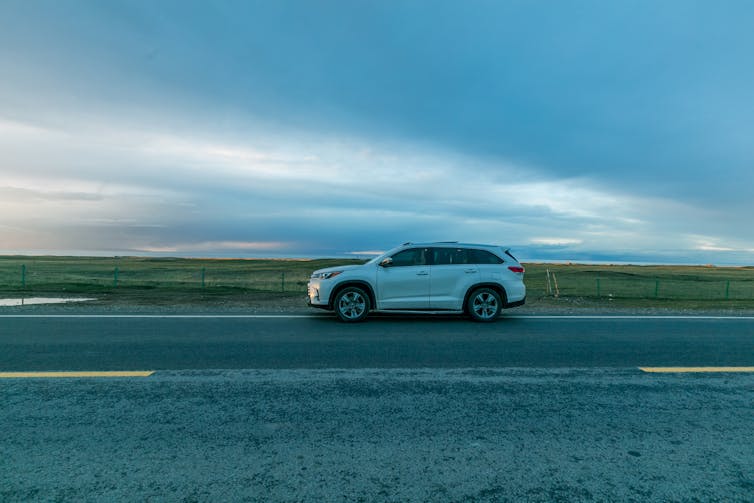
And Australia’s standards must also eliminate loopholes that could allow companies to comply with regulations but not actually improve fuel efficiency to the extent intended.
The considerations listed above are by no means exhaustive. And new fuel efficiency standards must be supported by other policy measures, such as reducing our reliance on private cars, and promoting public transport, walking and cycling.
Transport is Australia’s third-biggest source of greenhouse gas emissions, and federal government moves to tackle this problem are welcome. But if fuel efficiency standards are not carefully designed, the sector will continue to let down motorists, and the planet.![]()
Robin Smit, Adjunct Associate Professor, University of Technology Sydney; Hussein Dia, Professor of Future Urban Mobility, Swinburne University of Technology, and Nic Surawski, Senior Lecturer in Environmental Engineering, University of Technology Sydney
This article is republished from The Conversation under a Creative Commons license. Read the original article.
Frozen in time, we’ve become blind to ways to build sustainability into our urban heritage

It was hard to keep up with all the bad news coming out of the recent Australia State of the Environment report. The dire state of natural places and First Nations heritage rightly attracted attention. However, one important finding was overlooked: the poor state of Australia’s so-called historic heritage.
The report found this heritage is at risk on many fronts. It’s under pressure from land development, resource extraction, poorly managed tourism, climate change and inadequate management and protections.
In a familiar framing, the report points the finger at urban development and other changes. However, this mindset itself is actually an obstacle to protecting our urban heritage.
Change in our cities, and to our heritage, is both inevitable and necessary. Our relationships to neighbourhoods and places constantly evolve, as we learnt during COVID-19 lockdowns.
Policy ideas framed by sustainability, such as adaptive management that encourages heritage places to change and evolve, are more sensible. Flexible and creative responses to heritage places should be allowed.
An example of embracing change is the Walsh Bay Arts Precinct in Sydney. The project has reimagined maritime heritage for culture and the arts.
Adopting new perspectives won’t only preserve our historic buildings and places by enabling us to shape them for today’s needs. It will also mean urban heritage can contribute to cities becoming more socially, economically and environmentally sustainable.
A Problem Of Definitions
The historic heritage that the report finds is deteriorating refers to places, buildings and structures dating from 1788 onwards. But the very idea of “historic heritage” is out-of-date.
The term originally contrasted colonial built heritage with so-called “pre-history”. Indigenous heritage was generally seen as being in the past rather than continuing into the present or having a future.
A more precise term, “cultural heritage”, embraces the diverse historical and societal values that shape cities and historic environments. It better recognises that our urban cultural heritage is a product of colonisation and dispossession and located on Indigenous Country.
On the ground, we see a few examples of more progressive activities. The deeply researched City of Melbourne Hoddle Grid Review embraced Indigenous perspectives, social values and modern buildings. But this is an unusual case of innovation.
A Problem Of Knowledge
For heritage to contribute more to social sustainability, by ensuring places reflect and strengthen diverse communities, we need more robust knowledge about existing protections.
We simply lack that data. Australia has no heritage reporting mechanisms across national, state and local heritage jurisdictions.
As a result, the State of the Environment report was unable to provide a fuller picture of the state of urban heritage: what is protected, why and how it is protected, nor its values and condition. The report was not funded for this kind of comprehensive data collection, nor for widespread site visits.
We cannot identify which Australian communities and histories – whether First Nations, colonial or multicultural stories – are represented within heritage lists. The five-year report identifies only six targeted projects exploring gaps in state heritage registers. Only one of these studies foregrounds social value.
Centralising community perspectives in heritage remains a challenge. For example, when the City of Ballarat collaborated with residents to identify places of importance, the insights could not be translated into protections because planning laws don’t adequately recognise community heritage expertise. Work needs to be done to integrate heritage management and social sustainability.
A Problem Of Adaptation
Expanding the scope of urban heritage enables new perspectives on how it can contribute to economic and environmental sustainability. Economic development can threaten heritage, but also rescue it from decay. Leading heritage projects treat existing physical and social spaces as significant but underutilised resources.
The regeneration of Sydney’s Kings Cross, for example, seeks to return glitz and glamour to the area, albeit minus its gritty and subversive character. Heritage and communities are both enhanced and diminished through development and investment.
The report rightly identifies climate change as a threat to heritage places. Yet, across jurisdictions, inadequate emphasis is placed on heritage as a driver of climate adaptation. Reworking existing environments, buildings and structures, whether or not they are heritage-listed, is a sustainability trend.
Indeed, the report encourages the retention of existing buildings for their embodied energy due to the resources that have gone into constructing and maintaining them. But it maintains the premise that development tends to undermines conservation.
This longstanding mindset stands in the way of widespread adaptive reuse. Adopting broader perspectives and new approaches empowers heritage for sustainability agendas.
Although not heritage-listed, Broadmeadows Town Hall (1964) in Melbourne has been conserved and transformed in a sophisticated and functional way. At Melbourne’s Southbank, the listed Robur Tea House may soon finally be revitalised. Reworking the 1880s industrial building with a skyscraper above may well be the best way forward.
What’s Stopping Us From Doing Better?
With clear parallels to today, the Inquiry into the National Estate reported in 1974 that Australia’s heritage had been “downgraded, disregarded, and neglected”. The Commonwealth government took dramatic action by establishing the independent and innovative Australian Heritage Commission (1975–2004).
In recent times, however, the Commonwealth has greatly reduced its involvement in conserving urban heritage. Every state and local government now has its own approaches, resulting in fragmented governance arrangements. The lack of national leadership, co-ordination and innovation has led to us falling behind international approaches.
Urban heritage can strengthen communities and help foster an inclusive and democratic society only by engaging with a diversity of places and stories. Widespread adaptation and reuse of both listed and non-listed heritage places can support economic and environmental sustainability.
New and radical perspectives are needed to keep heritage relevant and thriving in cities.
James Lesh’s book Values in Cities: Urban Heritage in Twentieth-Century Australia will be launched at the Robin Boyd Foundation in Melbourne on August 24 2022.![]()
James Lesh, Lecturer in Cultural Heritage and Museum Studies, Deakin University
This article is republished from The Conversation under a Creative Commons license. Read the original article.
If you thought this summer’s heat waves were bad, a new study has some disturbing news about dangerous heat in the future

As global temperatures rise, people in the tropics, including places like India and Africa’s Sahel region, will likely face dangerously hot conditions almost daily by the end of the century – even as the world reduces its greenhouse gas emissions, a new study shows.
The mid-latitudes, including the U.S., will also face increasing risks. There, the number of dangerously hot days, marked by temperatures and humidity high enough to cause heat exhaustion, is projected to double by the 2050s and continue to rise.
In the study, scientists looked at population growth, economic development patterns, energy choices and climate models to project how heat index levels – the combination of heat and humidity – will change over time. We asked University of Washington atmospheric scientist David Battisti, a co-author of the study, published Aug. 25, 2022, to explain the findings and what they mean for humans around the world.
What Does The New Study Tell Us About Heat Waves In The Future, And Importantly The Impact On People?
There are two sources of uncertainty when it comes to future temperature. One is how much carbon dioxide humans are going to emit – that depends on things like population, energy choices and how much the economy grows. The other is how much warming those greenhouse gas emissions will cause.
In both, scientists have a really good sense of the likelihood of various scenarios. For this study, we combined those estimates to get a likelihood in the future of having dangerous and life-threatening temperatures.
We looked at what these “dangerously high” and “extremely dangerous” levels on the heat index would mean for daily life in both the tropics and in the mid-latitudes.
“Dangerous” in this case refers to the likelihood of heat exhaustion. Heat exhaustion won’t kill you if you’re able to stop and slow down – it’s characterized by fatigue, nausea, a slowed heartbeat, possibly fainting. But you really can’t work under these conditions.
The heat index indicates when a person is likely to reach that threshold. The National Weather Service defines “dangerous” as a heat index of 103 F (39.4 C), and “extremely dangerous” as 125 F (51.7 C). If a person gets to “extremely dangerous” temperatures, that can lead to heat stroke. At that level, you have a few hours to get medical attention to cool your body down, or you die.
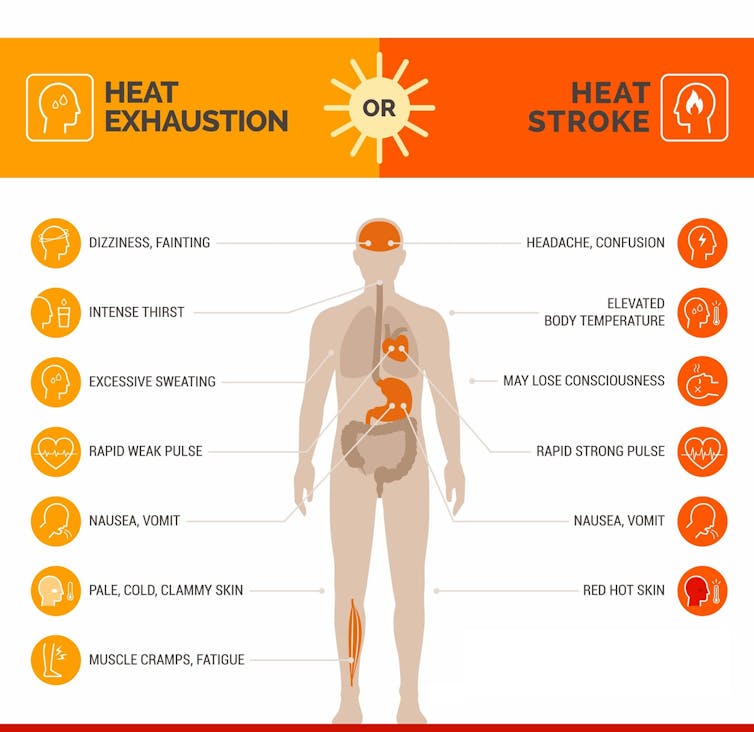
“Extremely dangerous” heat index conditions are almost unheard of today. They happen in a few locations near the Gulf of Oman, for example, for maybe a few days in a decade.
But the odds of the number of “dangerous” days are increasing as the planet warms. We’ll likely have about the same weather variability as today, but it’s all happening on top of a higher average temperature. So, the likelihood of extremely hot conditions increases.
What Does Your Study Show For Each Region?
In the mid-latitudes by 2050, we’ll see the number of dangerous heat days double in the most likely future scenario – even under modest greenhouse gas emissions that would meet the Paris climate agreement target of keeping warming under 2 C (3.6 F).
In the Southeastern U.S., the most likely scenario is that people will experience a month or two of dangerous heat days every year. The same is likely in parts of China, where some regions have been sweating through a summer 2022 heat wave for over two straight months.
We found that by the end of the century, most places in the mid-latitudes will see a three- to tenfold increase in the number of dangerous days.
In the tropics, such as parts of India, the heat index right now can exceed the dangerous level for a few weeks a year. It’s been like that for the past 20 to 30 years. By 2050, those conditions are likely to occur over several months each year, we found. And by the end of the century, many places will see those conditions most of the year.
What that means in practice is if you’re a rich country like the U.S., most people can afford or find air conditioning. But if you’re in the tropics, where about half the world’s population lives and poverty is higher, the heat is a more serious problem for a good part of the year. And a large percentage of people there work outside in agriculture.
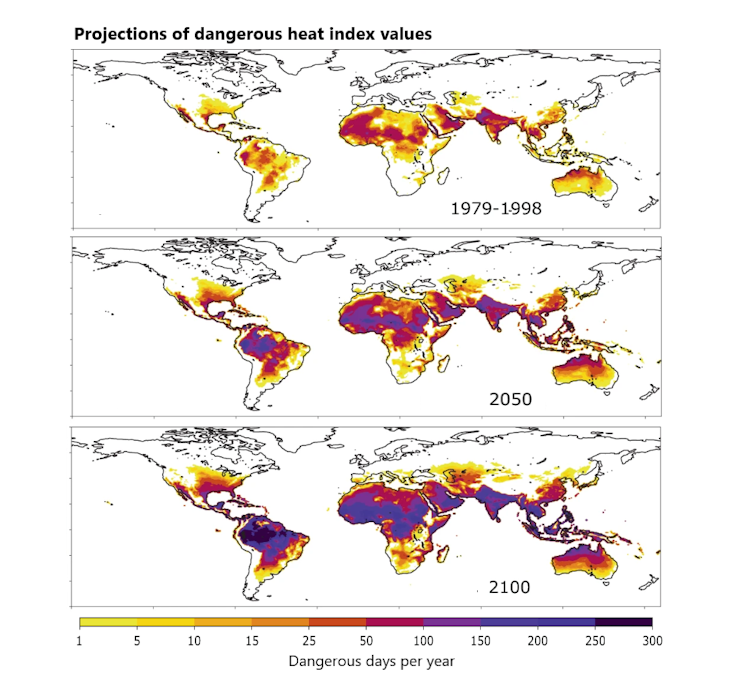
As we get toward the end of the century, we’ll start exceeding “extremely dangerous” conditions in several places, primarily in the tropics.
Northern India could see over a month per year in extremely dangerous conditions. Africa’s Sahel region, where poverty is widespread, could see a few weeks of extremely dangerous conditions per year.
Can Humans Adapt To What Sounds Like A Dystopian Future?
If you’re a rich country, you can build cooling facilities and generate electricity to run air conditioners – hopefully they won’t be powered with fossil fuels, which would further warm the planet.
If you’re a developing country, a very large fraction of people work outdoors in agriculture to earn money to buy food. There, if you think about it, there aren’t a lot of options.
Migrant workers in the U.S. also face more difficult conditions. A farm might be able to provide cooling facilities, but farmers’ margins are pretty small and migrant workers are often paid by volume, so when they aren’t picking, they aren’t paid.
Eventually, conditions will get to the point that more workers are overheating and dying.
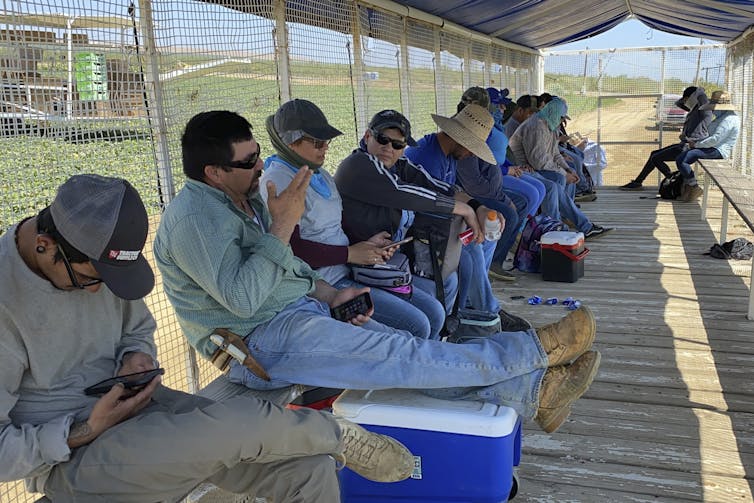
The heat will be a problem for crops, too. We expect most of the major grains to be less productive in the future because of heat stress. In the mid-latitudes right now, we’re close to optimal temperatures for growing grains. But as temperatures increase, grain yield goes down. In the tropics, that could be anywhere between a 10% to 15% reduction per degree Celsius increase. That’s a pretty big hit.
What Can Be Done To Avoid These Risks?
Part of our work in this study was determining the odds that the world will actually meet the Paris agreement. We found that to be around 0.1%. Basically, it’s not going to happen.
By the end of the century, we found the most likely scenario is that the planet will see 5.4 F (3 C) of warming globally compared to pre-industrial times. Land warms faster than ocean, so that translates to about a 7 F (3.9 C) increase for places where we live, work and play – and you can get a sense of the future.
The faster renewable energy comes online and fossil fuel use is shut down, the better the chances of avoiding that.![]()
David Battisti, Professor of Atmospheric Sciences, University of Washington
This article is republished from The Conversation under a Creative Commons license. Read the original article.
Hunger is increasing worldwide but women bear the brunt of food insecurity

Recent UN data on food insecurity paints a bleak picture of a growing international problem: global hunger is not only growing but it disproportionately affects women. Similarly, the international humanitarian aid organisation, CARE, estimates that 150 million more women than men went hungry in 2021.
Despite gains in global food security since 2015, food security has gone backwards, with an increase of 150 million people experiencing hunger since 2019.
The UN reports that globally, 2.3 billion people were food insecure in 2021 with 276 million (12%) facing severe food insecurity. This rapid and sustained increase in hunger over a short time is highly concerning. So too, is the growing gender gap, with 32% of women compared to 27.5% of men going hungry.
Why Are Women More Affected By Food Insecurity Than Men?
To answer this question, the global food system needs to be understood as a mirror of society. It reflects income inequalities and the uneven distribution of goods and services and, as such, is likely to show the same underlying structural inequalities as society at large.
The causes of food insecurity are complex and multi-dimensional. However, two important dimensions are the availability of food (is there enough food?) and the accessibility of food (is it affordable?).
Recently, the availability of food has been challenged by climate crises, conflicts, and disruptions due to the COVID-19 pandemic. At the same time, cost of living pressures have pushed the accessibility of food beyond the means of many people in both developed and developing countries.
On official measures of gender equality, women tend to experience a lower socio-economic status than men. Globally, 388 million women and girls live in extreme poverty right now, compared to 372 million men and boys. Oxfam reports that women earn 24% less than men, work longer hours, have more precarious work and do at least twice as much unpaid work.
The Impact Of Other Forms Of Inequality
Income disparities are also important to consider. Even when food is in abundance, with a few exceptions, it cannot be accessed without money. Accordingly, a bigger gender gap in income equality also means women have fewer means to purchase food.

The disadvantage of women has also been described in terms of their lack of agency to change their circumstances. In developing countries where subsistence farming is a key means of food provision, structural inequalities in land tenure and access to credit undermine women’s ability to generate income. Women make up 43% of the agricultural workforce, yet own less than 15% of land.
Improved women’s agency is strongly correlated with a reduction in poverty and has been recognised by the Higher Level Panel of Experts on Food Security as a critical dimension of food security.
Australia Also Has Severe Food Insecurity, But Women Aren’t Counted
Despite being the “lucky country,” Australia does not have a food security policy, nor does it collect the data necessary for an informed and targeted response.
In fact, the Department of Agriculture, Fisheries and Forestry argues that concerns about food security are “understandable, yet misplaced” because Australia “[…] produces substantially more food than it consumes.”
The narrative might work in terms of availability of food but overlooks key issues regarding its accessibility, including gender dimensions, the difference between individual, household and domestic food security, and the link between poverty and food insecurity.
Some of these data gaps have been filled by Food Bank, a food relief organisation, that conducts annual surveys on food insecurity in Australia. Their recent data reveals 17% of Australian adults are “severely” food insecure. While the data is not segregated by gender, we can surmise a food insecurity gap if we use income as a proxy.

Indeed, the Australian parliament reports that women’s median weekly earnings were 25% lower than men’s in 2019, suggesting women may also have reduced access to food. We may also expect a “food security gap” with other marginalised groups such as the aged, people with disabilities, sole parents, and Indigenous populations.
Future Responses
Severe levels of food insecurity are currently increasing in all regions of the world, and women are faring worse than men. Gender inequality worldwide intensifies the lack of access to food for women.
Recognising that women’s food security cannot be separated from broader concerns of agency, policies must consider the specific issues of gender equality, women’s rights and empowerment.
To do this, governments must also institute funded, systematic data collection, segregated by gender. Improved knowledge and transparency is central to policies aiming to strengthen women’s agency, lift women out of poverty and ensure the food security gender gap does not widen.![]()
Carol Richards, Associate professor, Queensland University of Technology and Rudolf Messner, Postdoctoral research fellow, Queensland University of Technology
This article is republished from The Conversation under a Creative Commons license. Read the original article.
What the High Court decision on filming animals in farms and abattoirs really means

What do farm animals have to do with the Australian Constitution?
Should the public know what happens in abattoirs and farms? Do we have the right to publish footage of what happens to animals in slaughterhouses? Should governments be able to make laws criminalising it? How do we best protect the privacy of farmers and prevent trespass?
The High Court considered these issues in Farm Transparency v New South Wales, handing down its judgment this month. This case concerned sections 11 and 12 of the Surveillance Devices Act 2007 (NSW): section 11 prohibits the publication or communication of footage or photographs of “private activities”, including intensive farming and slaughtering operations, with penalties of up to five years in prison. Section 12 criminalises the possession of such recordings.
In 2015, Farm Transparency Project’s director, Chris Delforce, was charged with publishing footage and photos depicting lawful practices at piggeries. The footage related to the use of carbon dioxide gas as a means of slaughtering animals.
While the charges were eventually dismissed, animal welfare organisations are concerned the legislation will obstruct legitimate whistleblowing (and public access to information) about the agricultural industry. There are also concerns the legislation may dampen the willingness of media to grapple with these issues. In turn, this may limit the ability of the Australian consumer to make informed choices about what they eat, and hinder public discussions about animal welfare due to a lack of information.
In that context, Farm Transparency took legal action arguing that the Surveillance Devices Act was in breach of the “freedom of political communication” implicitly protected by the Australian Constitution. In doing so, they turned an animal welfare and consumer rights issue into a constitutional issue.
What Is The Implied Freedom Of Political Communication?
Australia, unlike all other western democracies, does not have a federal bill of rights. This means there is no stand-alone right to free expression or speech.
However, freedom of political communication is implied from sections 7 and 24 of the Australian Constitution, which require that elected representatives be “chosen by the people”.
The courts have held previously that this implies laws should not limit our communication on political matters because that influences our choice of representative. This means state or federal laws that disproportionately “burden” communication about political matters can be struck down as unconstitutional.
The High Court has repeatedly emphasised that the freedom of political communication is not absolute, nor is it a personal right. Rather, laws directed at a legitimate objective that are reasonable and adapted to that objective will still be valid.
In this case, the question before the court was whether the Surveillance Devices Act 2007 is “suitable”, “necessary” and “balanced” in pursuing a legitimate objective. These questions have also been considered before by the court in relation to, for example, protesting, tweeting, political donations, bail conditions, and media reporting.
What Did The High Court Decide?
Four members of the court (Kiefel CJ, and Keane, Edelman, and Steward JJ) held that while the legislation did burden political communication, it also has a legitimate purpose of privacy. They also held that the offence provisions were proportionate to that purpose. Another judge (Gordon J) “read down” the reach of the provisions, which meant she thought they had limited scope and couldn’t be enforced to restrict publication of political communication.
Notably, two judges disagreed with the majority view (Gageler and Gleeson JJ), and found that the legislation was invalid. In their view, sections 11 and 12 impose blanket prohibitions and do so indiscriminately. In particular, Gageler J thought “The prohibitions are too blunt; their price is too high”.
However, ultimately the majority view was that sections 11 and 12 are constitutionally valid.
Of significance to those interested in animal welfare is that Kiefel CJ and Keane J accepted it was “a legitimate matter of governmental and political concern”. However, in their views, the relevant provisions in this case were not directed at restricting the content of the communications, but to the manner (such as trespass) in which they were obtained.
Why Does This Matter?
This decision means improved conditions for farm animals needs to be achieved by legislative and policy reform. Concerned consumers must convince parliaments to improve legal protections for non-human animals.
The issue is unlikely to go away. Animal welfare groups are increasingly concerned about standards of care and the manner in which animals are raised and slaughtered. Consumers are savvier in the information age and prefer choice.
The recognition of animal sentience and animal rights may eventually curtail the ability to engage in large-scale factory farming. This in turn will contribute to overall efforts to mitigate climate change and other environmental effects.
There is also the overarching issue of the legal protection offered to whistleblowers generally and the inherent problem in restricting information necessary for meaningful public debate.
Individuals and organisations do have legitimate expectations of privacy. However, disclosing reasonable concerns about conduct is an important tool in maintaining good governance and advancing accountability. Protections for whistleblowers are limited in Australia and there is space for legislative reform on this.![]()
Danielle Ireland-Piper, Associate Professor of Constitutional and International Law, Bond University
This article is republished from The Conversation under a Creative Commons license. Read the original article.
Not all of us have access to safe drinking water. This clever rainwater collector can change that

Access to clean drinking water is fundamental to our health and wellbeing, and a universal human right. But almost 200,000 Australians are still forced to use water contaminated with unsafe levels of various chemicals and bacteria. The situation is especially dire in remote areas.
To tackle this issue, we have developed an integrated rainwater harvesting unit at Western Sydney University (WSU).
This simple system can produce safe drinking water for households and communities in remote areas. It’s cheap, easy to use, and could improve the lives of thousands of people.
Far From City Life
In large Australian cities, we are used to turning on the tap – clean, plentiful water is always there, coming from the central water supply. We also take for granted the use of potable water for other uses, such as car washing, gardening and laundry.
But in rural and remote Australia, communities must develop private water supply systems to get safe drinking water from other sources. These can be rainwater, groundwater, surface water and “carted water” – treated water from a supplier.
Among these sources, harvested rainwater is considered to be the second-safest option after mains supply, according to the private water supply risk hierarchy chart. So, many residents in rural and remote Australia are using rainwater for their needs.
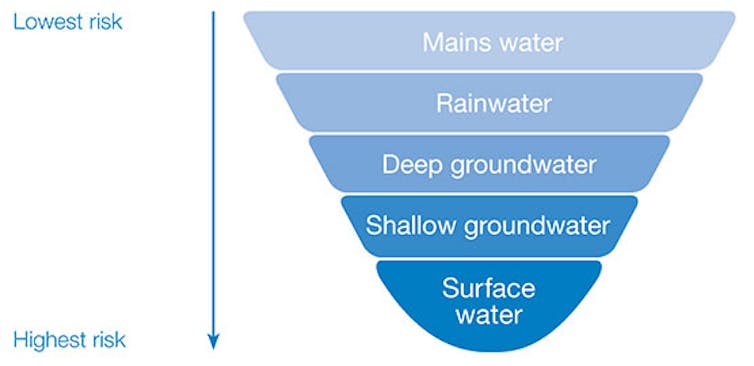
But rainwater isn’t always safe to drink without adequate treatment, as it can be contaminated from various sources, including air pollution, runoff chemicals, animal droppings, and more.
Unknown Water Quality
In Australia, roughly 400 remote or regional communities don’t have access to good quality drinking water, and 40% of those are Indigenous communities.
According to a 2022 drinking water quality report by Australian National University researchers, at least 627,736 people in 408 rural locations have drinking water that doesn’t meet at least one of the standards set by the Australian Drinking Water Guidelines.
Although the 2022 United Nations Sustainable Development Goals progress report declares that 100% of the Australian population has access to safe and affordable drinking water, it seems this report excluded about 8% of the population living in regional and remote areas.
The issue could be even more widespread due to lack of adequate testing.
Better Options Are Available
Our low-cost rainwater harvesting unit can produce safe drinking water that meets Australian guidelines, particularly maintaining Escherichia coli and nitrate levels below the recommended limits.
Most importantly, the system is integrated, which means it both collects rainwater, and treats it to be safe for household use.
The system is sustainable, uses locally available materials (such as gravel, sand, charcoal, limestone and stainless steel wire mesh or even cheesecloth), needs minimal maintenance, and is simple to operate. Communities can be trained to use these water systems regardless of technological skill level.

It’s also affordable. The cost of the drinking water produced through this system would be just over 1 cent per litre, according to a recent technical and financial feasibility analysis.
Ready To Use, With Improvements On The Way
Despite their simplicity, these rainwater filter systems don’t even have to be confined to individual households – we can scale them up so entire communities can benefit.
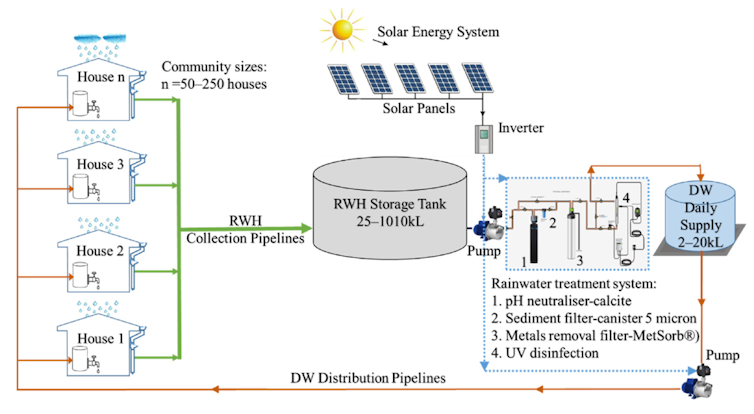
A case study has proved this in both developed and developing countries. Our collaborators in Bangladesh made the first move to adopt this technology, supplying safe drinking water to student accommodation at the Khulna University of Engineering & Technology.
We are also working on improvements. For example, we are building an automated system that can monitor the water quality from the unit regularly and adjust disinfectant dosing to keep it safe for drinking. We’re also developing a method for the system to sense when the filter materials need cleaning, and even start this process automatically.
In Australia, there is a clear need to improve water quality in remote communities. Adopting our simple rainwater filtering system would help communities to produce safe drinking water at minimum cost, and the WSU team is ready to work with local shire councils and groups from different remote communities to transfer the knowledge.![]()
Md Abdul Alim, Associate lecturer, Western Sydney University; Ataur Rahman, Professor, Western Sydney University, and Zhong Tao, Professor, Western Sydney University
This article is republished from The Conversation under a Creative Commons license. Read the original article.
The survival of the endangered monarch butterfly depends on conservation beyond borders

The iconic North American monarch butterfly Danaus plexippus plexippus was recently listed in the IUCN’s Red List of Threatened Species, signalling that its ongoing decline could lead to extinction. The compounding effects of habitat degradation, insufficient food and water and climate change have led to these dwindling numbers.
This tiny, almost weightless, butterfly can travel thousands of kilometres across natural and human-made borders with ease. It can survive harsh weather during its long-distance flights across Canada, the U.S. and Mexico. And it has developed, over millennia, these movements in a delicate relationship with its milkweed host plant.
Despite their remarkable adaptations and ongoing conservation efforts, things have gone downhill for these monarchs. Why? Part of the answer lies in our misguided approach to protecting them.
As a social anthropologist, I have followed this butterfly across North America over the past decade. I document how monarchs are natural crossers, uniting people, fields of expertise and countries. What is at risk of disappearing with them, I argue, is the wonder of a natural connector. And we need to unite to truly protect them.
Monarch Butterflies Need People
Most monarch conservation initiatives are grounded in a false separation of nature and society. Monarch conservation reserves are based on a western ideal of pristine nature, fenced off from humans.
National parks that protect monarchs removed — sometimes forcefully — local people, including Indigenous groups who have long lived sustainably with these insects. This separation caused the monarchs to suffer from that disconnection from the communities which followed agricultural practices that protected them.
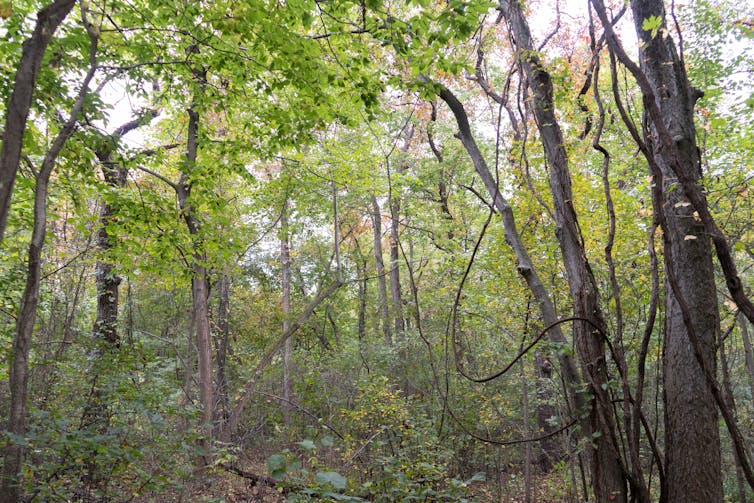
In Mexico, forest extensions that used to be community commons (later a Biosphere Reserve to protect monarchs) have been converted into avocado plantations. In Canada, the emblematic Point Pelee National Park that hosts monarchs at their fall migration also substituted monarch habitat with wooded areas that are not suitable for monarchs. Creating this National Park entailed evicting the Caldwell First Nation from their ancestral land.
Borders Affect Monarch Conservation
Monarchs are negatively affected by national borders. The U.S., Canada and Mexico have different environmental laws and political priorities.
Monarchs are protected when they spend the winter in the cool and humid forests of central Mexico, but the migratory route is still not fully integrated into the conservation plan. In Canada, monarchs are listed as endangered but protected differently across provinces and in the United States, monarchs are still not listed as endangered.
These protective measures keep changing and political and economic motivations can take precedence over the genuine need to care for monarch habitat trans-nationally. For example, a butterfly enthusiast can freely collect and rear monarchs in captivity in most of the U.S., but not in Ontario.
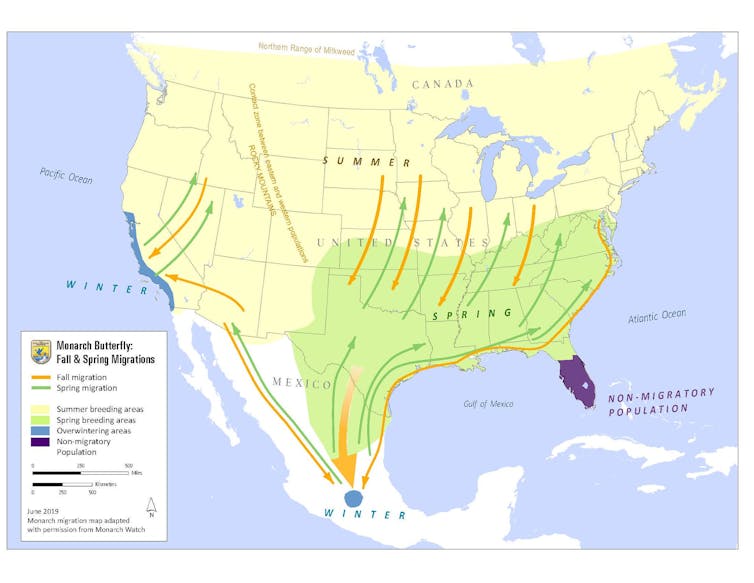
Monocrop Displaces Milkweed And Monarchs
Monarchs live in an unequal North America — a region that is integrated economically and geographically, but marked by inequality based on race, class and citizenship. The fates of marginalized residents are closely tied to those of the monarch.
This is seen in monocrop agriculture, which has displaced Indigenous people and destroyed habitats for monarchs and other pollinators by changing the native landscape.
Meanwhile, agribusiness, which is both a push and pull factor in the precarious migration of Mexican farmers, has also displaced the milkweed in what is known as the Canadian and U.S. corn belt.
Rethinking Conservation Strategies
Monarchs’ migrating behaviour entails crossing nature and human-made barriers despite the added difficulties of this journey.
Instead of more fragmentation and boundaries (around countries, parks and people), what monarchs need to survive is for us to emulate their “crossing” behaviour. We must ask: how can we create more and better crossings?
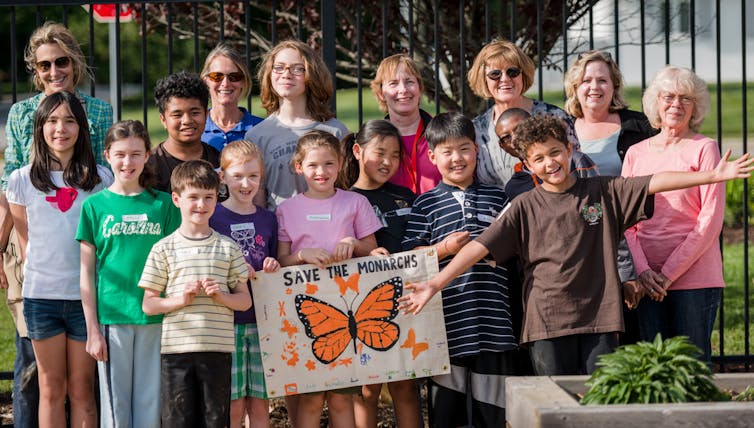
To enable more crossings, we need to de-centre the role of conservation experts as leaders of monarch protection policies. Actions to save the monarch butterfly should be planned with — not merely in consultation with — Indigenous peoples who have ancestrally lived with this insect.
We also need to begin democratizing monarch knowledge. This would include accounting for the role of citizen scientists in monarch protection. They should be viewed not merely as amateurs or “helpers” in scientific research, but as knowledge producers and, ideally, policy-makers in their own right.
Despite the harsh reality of its path to extinction, we should see the latest monarch listing as an opportunity. We have a short, but potential window to redirect our conservation efforts by connecting crossing fields and boundaries to ensure the survival of this insect and, perhaps, secure a better future for us as well.
We need to move beyond the goal of saving a beloved butterfly to learning from it about how to safeguard our collective futures.![]()
Columba González-Duarte, Assistant Professor, Sociology & Anthropology, Mount Saint Vincent University
This article is republished from The Conversation under a Creative Commons license. Read the original article.
Pittwater Reserves: Histories + Notes + Pictorial Walks
A History Of The Campaign For Preservation Of The Warriewood Escarpment by David Palmer OAM and Angus Gordon OAM
America Bay Track Walk - photos by Joe Mills
An Aquatic June: North Narrabeen - Turimetta - Collaroy photos by Joe Mills
Angophora Reserve Angophora Reserve Flowers Grand Old Tree Of Angophora Reserve Falls Back To The Earth - History page
Annie Wyatt Reserve - A Pictorial
Avalon's Village Green: Avalon Park Becomes Dunbar Park - Some History + Toongari Reserve and Catalpa Reserve
Bairne Walking Track Ku-Ring-Gai Chase NP by Kevin Murray
Bangalley Headland Bangalley Mid Winter
Banksias of Pittwater
Barrenjoey Boathouse In Governor Phillip Park Part Of Our Community For 75 Years: Photos From The Collection Of Russell Walton, Son Of Victor Walton
Barrenjoey Headland: Spring flowers
Barrenjoey Headland after fire
Bayview Baths
Bayview Wetlands
Beeby Park
Bilgola Beach
Botham Beach by Barbara Davies
Bungan Beach Bush Care
Careel Bay Saltmarsh plants
Careel Bay Birds
Careel Bay Clean Up day
Careel Bay Playing Fields History and Current
Careel Creek
Careel Creek - If you rebuild it they will come
Centre trail in Ku-ring-gai Chase National Park
Chiltern Track- Ingleside by Marita Macrae
Clareville Beach
Clareville/Long Beach Reserve + some History
Coastal Stability Series: Cabbage Tree Bay To Barrenjoey To Observation Point by John Illingsworth, Pittwater Pathways, and Dr. Peter Mitchell OAM
Cowan Track by Kevin Murray
Curl Curl To Freshwater Walk: October 2021 by Kevin Murray and Joe Mills
Currawong and Palm Beach Views - Winter 2018
Currawong-Mackerel-The Basin A Stroll In Early November 2021 - photos by Selena Griffith
Currawong State Park Currawong Beach + Currawong Creek
Deep Creek To Warriewood Walk photos by Joe Mills
Drone Gives A New View On Coastal Stability; Bungan: Bungan Headland To Newport Beach + Bilgola: North Newport Beach To Avalon + Bangalley: Avalon Headland To Palm Beach
Duck Holes: McCarrs Creek by Joe Mills
Dunbar Park - Some History + Toongari Reserve and Catalpa Reserve
Dundundra Falls Reserve: August 2020 photos by Selena Griffith - Listed in 1935
Elsie Track, Scotland Island
Elvina Track in Late Winter 2019 by Penny Gleen
Elvina Bay Walking Track: Spring 2020 photos by Joe Mills
Elvina Bay-Lovett Bay Loop Spring 2020 by Kevin Murray and Joe Mills
Fern Creek - Ingleside Escarpment To Warriewood Walk + Some History photos by Joe Mills
Iluka Park, Woorak Park, Pittwater Park, Sand Point Reserve, Snapperman Beach Reserve - Palm Beach: Some History
Ingleside
Ingleside Wildflowers August 2013
Irrawong - Ingleside Escarpment Trail Walk Spring 2020 photos by Joe Mills
Irrawong - Mullet Creek Restoration
Katandra Bushland Sanctuary - Ingleside
Lucinda Park, Palm Beach: Some History + 2022 Pictures
McCarrs Creek
McCarr's Creek to Church Point to Bayview Waterfront Path
McKay Reserve
Mona Vale Beach - A Stroll Along, Spring 2021 by Kevin Murray
Mona Vale Headland, Basin and Beach Restoration
Mount Murray Anderson Walking Track by Kevin Murray and Joe Mills
Mullet Creek
Narrabeen Creek
Narrabeen Lagoon Catchment: Past Notes Present Photos by Margaret Woods
Narrabeen Lagoon State Park
Narrabeen Lagoon State Park Expansion
Narrabeen Rockshelf Aquatic Reserve
Nerang Track, Terrey Hills by Bea Pierce
Newport Bushlink - the Crown of the Hill Linked Reserves
Newport Community Garden - Woolcott Reserve
Newport to Bilgola Bushlink 'From The Crown To The Sea' Paths: Founded In 1956 - A Tip and Quarry Becomes Green Space For People and Wildlife
Pittwater spring: waterbirds return to Wetlands
Pittwater's Lone Rangers - 120 Years of Ku-Ring-Gai Chase and the Men of Flowers Inspired by Eccleston Du Faur
Pittwater's Parallel Estuary - The Cowan 'Creek
Resolute Track at West Head by Kevin Murray
Resolute Track Stroll by Joe Mills
Riddle Reserve, Bayview
Salvation Loop Trail, Ku-Ring-Gai Chase National Park- Spring 2020 - by Selena Griffith
Seagull Pair At Turimetta Beach: Spring Is In The Air!
Stapleton Reserve
Stapleton Park Reserve In Spring 2020: An Urban Ark Of Plants Found Nowhere Else
The Chiltern Track
The Resolute Beach Loop Track At West Head In Ku-Ring-Gai Chase National Park by Kevin Murray
Topham Track Ku-Ring-Gai Chase NP, August 2022 by Joe Mills and Kevin Murray
Towlers Bay Walking Track by Joe Mills
Trafalgar Square, Newport: A 'Commons' Park Dedicated By Private Landholders - The Green Heart Of This Community
Tranquil Turimetta Beach, April 2022 by Joe Mills
Turimetta Beach Reserve by Joe Mills, Bea Pierce and Lesley
Turimetta Beach Reserve: Old & New Images (by Kevin Murray) + Some History
Turimetta Headland
Warriewood Wetlands and Irrawong Reserve
Whale Beach Ocean Reserve: 'The Strand' - Some History On Another Great Protected Pittwater Reserve
Wilshire Park Palm Beach: Some History + Photos From May 2022
Winji Jimmi - Water Maze

New Shorebirds WingThing For Youngsters Available To Download
A Shorebirds WingThing educational brochure for kids (A5) helps children learn about shorebirds, their life and journey. The 2021 revised brochure version was published in February 2021 and is available now. You can download a file copy here.
If you would like a free print copy of this brochure, please send a self-addressed envelope with A$1.10 postage (or larger if you would like it unfolded) affixed to: BirdLife Australia, Shorebird WingThing Request, 2-05Shorebird WingThing/60 Leicester St, Carlton VIC 3053.

 Shorebird Identification Booklet
Shorebird Identification Booklet
The Migratory Shorebird Program has just released the third edition of its hugely popular Shorebird Identification Booklet. The team has thoroughly revised and updated this pocket-sized companion for all shorebird counters and interested birders, with lots of useful information on our most common shorebirds, key identification features, sighting distribution maps and short articles on some of BirdLife’s shorebird activities.
The booklet can be downloaded here in PDF file format: http://www.birdlife.org.au/documents/Shorebird_ID_Booklet_V3.pdf
Paper copies can be ordered as well, see http://www.birdlife.org.au/projects/shorebirds-2020/counter-resources for details.
Download BirdLife Australia's children’s education kit to help them learn more about our wading birdlife
Shorebirds are a group of wading birds that can be found feeding on swamps, tidal mudflats, estuaries, beaches and open country. For many people, shorebirds are just those brown birds feeding a long way out on the mud but they are actually a remarkably diverse collection of birds including stilts, sandpipers, snipe, curlews, godwits, plovers and oystercatchers. Each species is superbly adapted to suit its preferred habitat. The Red-necked Stint is as small as a sparrow, with relatively short legs and bill that it pecks food from the surface of the mud with, whereas the Eastern Curlew is over two feet long with a exceptionally long legs and a massively curved beak that it thrusts deep down into the mud to pull out crabs, worms and other creatures hidden below the surface.
Some shorebirds are fairly drab in plumage, especially when they are visiting Australia in their non-breeding season, but when they migrate to their Arctic nesting grounds, they develop a vibrant flush of bright colours to attract a mate. We have 37 types of shorebirds that annually migrate to Australia on some of the most lengthy and arduous journeys in the animal kingdom, but there are also 18 shorebirds that call Australia home all year round.
What all our shorebirds have in common—be they large or small, seasoned traveller or homebody, brightly coloured or in muted tones—is that each species needs adequate safe areas where they can successfully feed and breed.
The National Shorebird Monitoring Program is managed and supported by BirdLife Australia.
This project is supported by Glenelg Hopkins Catchment Management Authority and Hunter Local Land Services through funding from the Australian Government’s National Landcare Program. Funding from Helen Macpherson Smith Trust and Port Phillip Bay Fund is acknowledged.
The National Shorebird Monitoring Program is made possible with the help of over 1,600 volunteers working in coastal and inland habitats all over Australia.
The National Shorebird Monitoring program (started as the Shorebirds 2020 project initiated to re-invigorate monitoring around Australia) is raising awareness of how incredible shorebirds are, and actively engaging the community to participate in gathering information needed to conserve shorebirds.
In the short term, the destruction of tidal ecosystems will need to be stopped, and our program is designed to strengthen the case for protecting these important habitats.
In the long term, there will be a need to mitigate against the likely effects of climate change on a species that travels across the entire range of latitudes where impacts are likely.
The identification and protection of critical areas for shorebirds will need to continue in order to guard against the potential threats associated with habitats in close proximity to nearly half the human population.
Here in Australia, the place where these birds grow up and spend most of their lives, continued monitoring is necessary to inform the best management practice to maintain shorebird populations.
BirdLife Australia believe that we can help secure a brighter future for these remarkable birds by educating stakeholders, gathering information on how and why shorebird populations are changing, and working to grow the community of people who care about shorebirds.
To find out more visit: http://www.birdlife.org.au/projects/shorebirds-2020/shorebirds-2020-program
Aussie Bread Tags Collection Points

Protecting The Night Sky From Light Pollution: Why Does It Matter? Mariya Lyubenova
Look up this spring – you might see little ravens build soft, cosy nests from your garden trees
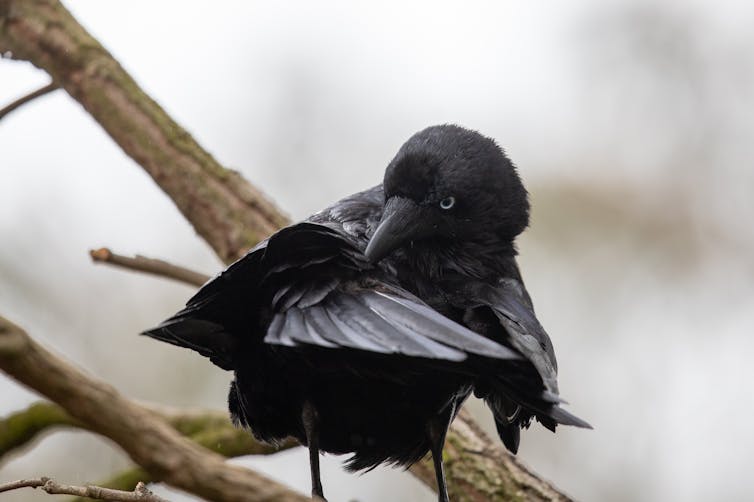
Spring is nearing and birds will soon start nesting in trees in backyards across Australia. The trees in our garden are now 40 years old – not old by tree standards, but old enough to be among the tallest in our suburb, offering refuge for local native birds.
When I propagated Monterey pine (Pinus radiata) seedlings for research in the mid 1970s, there were a few left over. I kept a couple, and one made a fine indoor Christmas tree for our young family in the early 1980s. My plan was to get rid of the tree but, after a few Christmases, the family was determined it would stay.
In the years since our tree, now in the garden, has grown to nearly 27 metres tall and almost 1m in diameter. It has become a favourite of many birds over the years and a nesting tree for ring-tailed possums.
A group of noisy but intelligent little ravens (Corvus mellori), have roosted in it, crowed from its lofty heights and battled others of the same and different species that have trespassed.
Over COVID lockdowns, I observed the curious behaviour of little ravens as they busily built their nests using the trees in my garden, and learned how they create a soft nest lining for their chicks. This spring you, too, can observe the delightful behaviour of birds as they visit your nearby trees and shrubs.
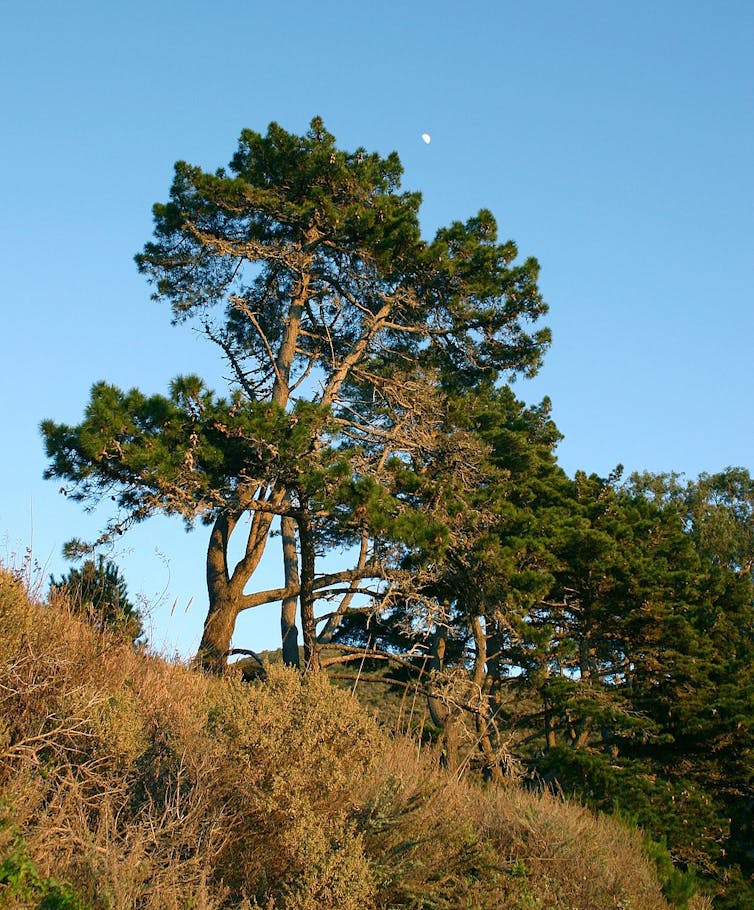
Little Ravens In Backyards
Monterey pine is an introduced species to Australia, and has significant potential to become a weed, so we regularly check for self-sown seedlings. So far our vigilance has paid off and there are no escapees in the parks, gardens and surrounds.
While I would never recommend its planting, we are going to make the most of its presence while we have it. Over the years the tree has provided great summer shade and some wonderful interactions with local wildlife.
The din when sulphur-crested and yellow-tailed black cockatoos make their visits to feed on cones has to be heard to be believed. The cockatoos drive the little ravens away as they enjoy the cones, but the little ravens keep a look out and return as soon as the cockatoos have finished feeding.
During lockdowns the avian demands, discussion and negotiations were a welcome and entertaining break.
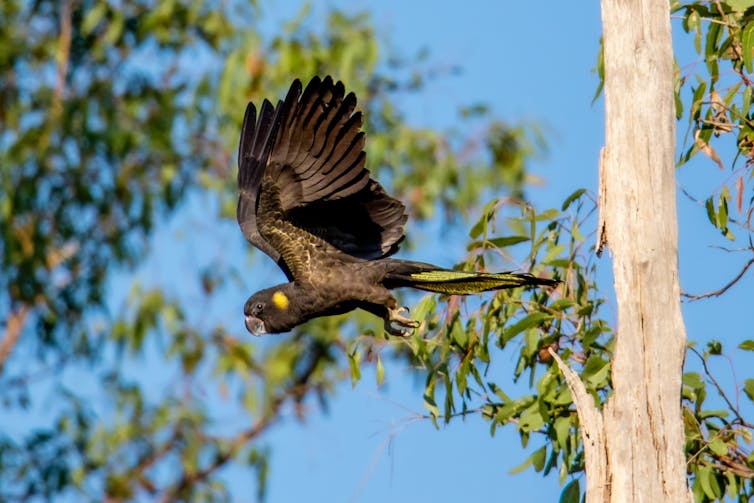
Little ravens aren’t likely to rank high in the list of popular birds, but there is much to be impressed by when you study them.
Despite their name, little ravens aren’t actually that little, at over 40 centimetres tall. They are common across southern Australia and will eat almost anything, plant or animal.
They’re intelligent birds and great scavengers, capable of opening food containers, raiding bins and devouring road kill. They have adapted well to humans and so are found in backyards across the country.
Building Cosy Nests
Another special tree in our garden is the messmate stringy bark (Eucalyptus obliqua). I grew it and hundreds of others from seed for research experiments in the late 1970s, and it comes from the Wombat Forest near Daylesford, Victoria.
Its spreading canopy provides fine dappled summer shade. And it’s almost inconspicuous white flowers cause the tree to hum from the visits of local bees, not to mention the visits of native honey eaters, such as the yellow wattlebird and the white plumed honeyeater.

Every spring for about 20 years I had noticed marks on the tree’s branches, and wondered what caused them. During lockdown, I observed little ravens peeling strips of the fibrous stringy bark from upper branches. These are private, unannounced visits without calls or fuss. You had to be alert to know the birds were there.
Many birds are expert home decorators. The little ravens know exactly what they’re after and where to find it, and harvest nest-building material from different parts of the tree.
In their first visits, they gather material for the basic structure of the nest, made from twigs. Once in place, they strip long, coarse strings of bark from lower and larger branches in the canopy.
A few days later, the birds return to some of the younger upper branches where they collect fine, almost fur-like snippets of bark. These will provide an ideal fine soft inner nest lining for hatching raven chicks.
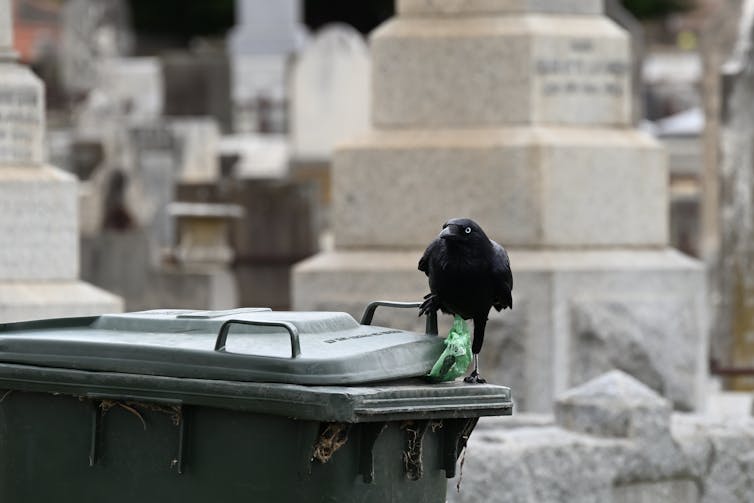
Observing Birds In Your Own Backyard
From my work with trees, I have come to appreciate some of the delicate and intimate relationships between fauna and flora and fungi.
I look for evidence of possum claw marks on heavily grazed trees and the damage to branches caused by the nibbling of the powerful beaks of sulphur-crested cockatoos. Now, I know the long strands pulled from the upper trunks and larger branches of messmate stringy bark are due to the careful work of little ravens lining their nests.
So at this time of the year, keep an eye out on both your garden plants and their avian visitors.
Look for birds darting, almost furtively, in and out of your trees, wisterias and rose bushes – they may have a nest within the foliage. Your prickly shrubs can afford protection to smaller birds and increase the chances of successful breeding.
Both native and introduced birds will be breeding in the next few weeks. And both native and introduced trees can be used by both for nesting.

Many of popular garden trees – such as wattles or introduced conifers – can host magpies and silvereyes. If you live near a creek, you may attract the superb fairy wren in a bottlebrush. And different finches may occur in your gum trees, roses or wisterias.
Native tree and shrub species with diverse flowering times can be beneficial to our native birds. They provide nectar and host native insects species in late winter and deliver a full bounty of resources in spring.
Trees with fine foliage and fibrous bark, such as stringy bark and some of the feathery-leaved wattles, are popular with birds at this time of year for nesting material.
This means your garden can be an important way to maintain local biodiversity. In a changing climate, we need all the diversity we can get!![]()
Gregory Moore, Senior Research Associate, School of Ecosystem and Forest Sciences, The University of Melbourne
This article is republished from The Conversation under a Creative Commons license. Read the original article.
Be The Boss: I Want To Be A Biotechnologist
- determine the objectives and methods of research
- collect and analyse data
- prepare reports based on your findings
- present the findings or publish reports
- keep administrative records.
- new vaccines to treat diseases
- genetically modified plants with resistance to pests
- improved detection of diseases
- treatments for human infertility
- bacteria capable of cleaning up oil spills or polluted land
- creating biological dyes or biodegradeable plastics
- environmentally friendly biofuels.
- a strong interest in science
- good technical scientific research skills
- an enquiring mind and good problem-solving skills
- a high level of accuracy and attention to detail
- the ability to analyse statistical and technical data
- good computer skills
- good written communication skills.

- Bioinformatics (also called "gold biotechnology") is an interdisciplinary field that addresses biological problems using computational techniques, and makes the rapid organization as well as analysis of biological data possible. The field may also be referred to as computational biology, and can be defined as, "conceptualizing biology in terms of molecules and then applying informatics techniques to understand and organize the information associated with these molecules, on a large scale". Bioinformatics plays a key role in various areas, such as functional genomics, structural genomics, and proteomics, and forms a key component in the biotechnology and pharmaceutical sector.
- Blue biotechnology is based on the exploitation of sea resources to create products and industrial applications. This branch of biotechnology is the most used for the industries of refining and combustion principally on the production of bio-oils with photosynthetic micro-algae.
- Green biotechnology is biotechnology applied to agricultural processes. An example would be the selection and domestication of plants via micropropagation. Another example is the designing of transgenic plants to grow under specific environments in the presence (or absence) of chemicals. One hope is that green biotechnology might produce more environmentally friendly solutions than traditional industrial agriculture. An example of this is the engineering of a plant to express a pesticide, thereby ending the need of external application of pesticides. An example of this would be Bt corn. Whether or not green biotechnology products such as this are ultimately more environmentally friendly is a topic of considerable debate. It is commonly considered as the next phase of green revolution, which can be seen as a platform to eradicate world hunger by using technologies which enable the production of more fertile and resistant, towards biotic and abiotic stress, plants and ensures application of environmentally friendly fertilizers and the use of biopesticides, it is mainly focused on the development of agriculture. On the other hand, some of the uses of green biotechnology involve microorganisms to clean and reduce waste.
- Red biotechnology is the use of biotechnology in the medical and pharmaceutical industries, and health preservation. This branch involves the production of vaccines and antibiotics, regenerative therapies, creation of artificial organs and new diagnostics of diseases. As well as the development of hormones, stem cells, antibodies, siRNA and diagnostic tests.
- White biotechnology, also known as industrial biotechnology, is biotechnology applied to industrial processes. An example is the designing of an organism to produce a useful chemical. Another example is the using of enzymes as industrial catalysts to either produce valuable chemicals or destroy hazardous/polluting chemicals. White biotechnology tends to consume less in resources than traditional processes used to produce industrial goods.
- Yellow biotechnology refers to the use of biotechnology in food production (food industry), for example in making wine (winemaking), cheese (cheesemaking), and beer (brewing) by fermentation. It has also been used to refer to biotechnology applied to insects. This includes biotechnology-based approaches for the control of harmful insects, the characterisation and utilisation of active ingredients or genes of insects for research, or application in agriculture and medicine and various other approaches.
- Grey biotechnology is dedicated to environmental applications, and focused on the maintenance of biodiversity and the remotion of pollutants.
- Brown biotechnology is related to the management of arid lands and deserts. One application is the creation of enhanced seeds that resist extreme environmental conditions of arid regions, which is related to the innovation, creation of agriculture techniques and management of resources.
- Violet biotechnology is related to law, ethical and philosophical issues around biotechnology.
- Dark biotechnology is the colour associated with bioterrorism or biological weapons and biowarfare which uses microorganisms, and toxins to cause diseases and death in humans, livestock and crops.
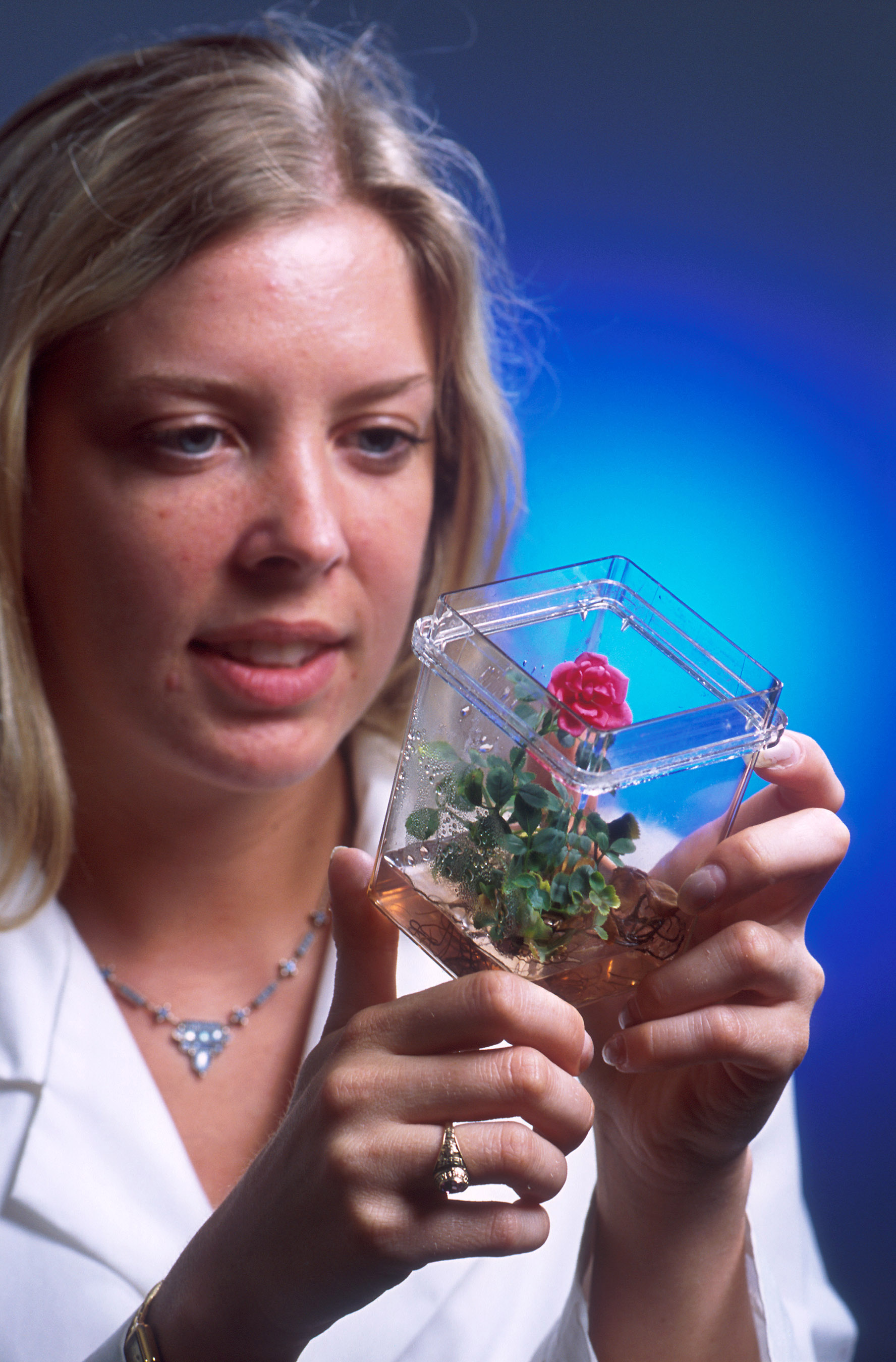
Also Available:
The Rite Of Holmgang (Viking Short Film)
More Opportunities To Get Skilled For Free
 NSW residents who want to get skilled for a first job, a new job or a better job will have more opportunities to access fee-free training, with the NSW Government extending funding through to the end of the 2022-23 financial year.
NSW residents who want to get skilled for a first job, a new job or a better job will have more opportunities to access fee-free training, with the NSW Government extending funding through to the end of the 2022-23 financial year.Art Competition To Remember Our ANZACS
Word Of The Week: Hippie
Noun
(especially in the 1960s) a person of unconventional appearance, typically having long hair, associated with a subculture involving a rejection of conventional values


Why do my feet smell? And what can I do about it?

“Smelly” might be the first word that comes to mind when you think of feet.
Why do some people’s feet have no smell, yet other feet are so pungent they could almost knock you out?
Let’s go through what causes smelly feet, what you can do about it, and when to seek professional advice.
Sweaty Feet
Sweaty feet can lead to smelly feet.
Feet can become sweaty in hot weather, especially if we wear a closed-in shoe or boot and the sweat doesn’t evaporate.
Anxiety and emotional stress also increase the activity of sweat glands due to the release of stress hormones such as adrenaline, causing sweaty hands and feet.
Sweaty feet are common, but some people have an excessive sweating condition called “hyperhidrosis”. It’s very distressing and can lead to social awkwardness, reduced self-confidence and poor mental health.
But sweat usually doesn’t have a smell by itself. It’s the bacteria that feast on sweat that cause the bad smell.
Bacteria And Sweat
Humans have around 1,000 species of bacteria living on our skin. Bacteria thrive in moist environments such as our armpits, groin and also in between our toes. The bacteria living on our skin are mostly harmless (and some are even good for us), but they can also cause odour when they interact with sweat.
Foot odour is associated with several types of bacteria. When these bacteria eat the sugars and fats in sweat, they produce chemicals with a noxious smell.
The most common chemical compounds are:
“isovaleric acid”, which has a distinctive cheesy, sweaty feet odour
“propionic acid”, which smells sour.
A type of bacteria called “brevibacteria” also cause foot odour. They eat dead skin on our feet, producing a gas which has a distinctive sour smell.
Cheesemakers will often add this bacteria to the surface of cheese to develop texture and flavour. This explains why many cheeses smell like feet, and feet smell like cheese!
Biologist Bart Knols received an “Ig Nobel” Prize (for unusual scientific achivements) in 2006 for demonstrating that a type of mosquito known for transmitting malaria has an equal preference for Limburger cheese and the smell of human feet.

What Else Can Cause Smelly Feet?
Foot odour is made worse by socks and shoes that don’t allow sweat to evaporate from the skin. When sweat can’t evaporate from the skin, the temperature and relative humidity rise inside footwear, particularly in shoes such as work boots. Bacteria prefer a warm, damp environment.
A bacterial skin infection called “pitted keratolysis” may also cause bad foot odour. It typically affects the soles of the feet and in between toes, and makes the skin white and soggy, often with clusters of small punched-out craters or “pits”. These pits are caused by bacteria digesting the skin and producing sulphur compounds.
It’s more common in men than women and is associated with sweaty feet, poor foot hygiene, diabetes and immunodeficiency. Pitted keratolysis will respond to treatment with antiseptic agents and topical antibiotics.
Foot odour can also be caused by tinea, a fungal skin infection often called athlete’s foot, which a podiatrist will be able to diagnose. It can be treated with an anti-fungal cream or lotion.
What You Can Do To Manage Sweaty And Smelly Feet
The first things to consider if you have smelly feet are foot hygiene and footwear.
Feet don’t wash themselves in the shower. In fact, bacteria from the rest of your body are washed down to your feet. So, it’s important to wash your feet with soap – including between your toes!
Drying your feet thoroughly after bathing is also important to prevent the build-up of sweat and bacteria.
It’s ideal to alternate your footwear so that shoes and boots have a chance to dry out before you wear them again. Damp footwear is the perfect place for bacteria to thrive and create those smelly chemicals.
Regular washing and drying of anything your wear on your feet will remove bacteria and stale sweat.
Bamboo has a natural antimicrobial effect (meaning it may have some ability to slow bacteria or mould growing), and socks made from this fibre may be helpful, but it’s unclear whether the benefits translate to bamboo clothing products.
There’s conflicting views on the best material for shoes and socks to improve smelly feet, so more research is needed.
Treatments For Sweaty And Smelly Feet
If your feet are stubbornly sweaty and smelly even with good foot hygiene and attention to footwear, you may need to consider some other options.
An expert opinion from a podiatrist will help you make an appropriate treatment choice and ensure more serious issues aren’t missed.
Most of the available treatments for body odour target sweat production:
a strong antiperspirant containing aluminium chloride hexhydrate, which can be purchased from a pharmacy without a prescription and applied directly to your feet
“iontophoresis” is a procedure offered at specialist clinics to reduce sweating in the hands and feet. A mild electrical current is passed through skin soaked in tap water. One study found around 75–80% of participants had reduced foot sweating after 20 days of this treatment
Botox treatments are highly effective in reducing foot sweating. Botox works by blocking the nerves that activate sweat glands. However, injections into the sole of your foot can be very uncomfortable
a topical cream containing a small amount of “glycopyrronium bromide” can help to control excessive sweating.
Caroline Robinson would like to thank Anna Horn from Charles Sturt podiatry, for her contribution to researching this article.![]()
Caroline Robinson, Associate Professor Podiatry, Charles Sturt University
This article is republished from The Conversation under a Creative Commons license. Read the original article.
Why does my breath smell bad, and what can I do about it?

Most of us can’t smell our own breath. If someone bravely informs you your breath smells, believe them, and do something about it. Or if you are worried you have bad breath, seek out a trusted opinion.
Your breath can be the first sign something in your body needs attention. Here are some tips to help you identify the cause, and how to fix it.
What Causes Bad Breath?
Of the many causes of bad breath, 90% originate from putrid-smelling bacterial by-products inside our mouth. These by-products form a bouquet of odours that can make our breath smell like rotten eggs (volatile sulphur compounds) or poo (methyl mercaptan/hydrogen sulphide).
The largest and most significant odour-cultivating culprit is our tongue. The back of our tongue is a perfect petri dish for bacteria that feed on dead cells, saliva proteins, sinus ooze and fluids from untreated gum disease.
These bacteria can form a furry coat on our tongue that permeates our breath. The good news is you can fix this by brushing your tongue when you clean your teeth.

Eating onion and garlic can add a sulphurous tone to your breath for up to three days, due mainly to food particles left behind. Tobacco smoking also causes bad mouth smells to linger. Pus from dental infections can also be a smelly culprit.
Hard-to-reach places in the mouth where the toothbrush just can’t seem to clean can act like greenhouses where unhealthy bacteria thrive. Spaces in faulty or broken fillings, holes in teeth, gaps (pockets) in the gums that form with advancing gum (periodontal) disease, as well as improperly cleaned dental implants, dentures and braces, all contribute to bad odours.
Your dentist or hygienist can help identify these smell-promoting reservoirs, and fix or clean them. They can also help customise your oral hygiene routine to improve your health and reduce malodour.
What About Morning Breath?
We all experience morning breath, with some suffering more than others. Morning breath occurs when our saliva flow slows or stops while we sleep. And without saliva to wash, dilute or flush, everything stagnates: food particles ferment and the bacteria multiply to release gassy odours.
This is why it is important to brush your teeth and gums, and use appropriate tools such as floss or interdental brushes before going to bed. If you are unsure, your dentist or hygienist will be able to identify which tools work best for you.
Other factors that reduce saliva include stress, anxiety, fasting, dehydration, antidepressants and blood-pressure-reducing medication, recreational drugs, caffeine and alcohol.
And if you tend to breathe through your mouth rather than your nose while asleep, your morning breath may be worse. Mouth-breathers can have sinus issues that block their noses to prevent proper breathing.

More Serious Causes
Chronic (long-term) sinusitis and tonsillitis can also cause bad breath (especially if the tonsilitis causes tonsil stones – smelly cheese-like clumps of bacteria, dead skin cells, keratin and foreign debris).
Occasionally, young children may insert small objects into their nasal passages, which causes a buildup of bacteria and a yucky smell.
What Do I Do If I Have Bad Breath?
For most of us, good oral hygiene, drinking plenty of water, avoiding tobacco products, regular dental visits, and chronic sinus and tonsillitis management will help avoid bad breath.
In some instances, we may choose to suffer the short-term consequences (because onion and garlic are delicious). Chewing sugar-free gum or mints may temporarily ease any issues caused by last night’s garlic pizza.
If you’re concerned, see your hygienist or dentist, who can diagnose and help you manage the cause of your bad breath.![]()
Arosha Weerakoon, Lecturer, General Dentist & PhD Candidate, The University of Queensland
This article is republished from The Conversation under a Creative Commons license. Read the original article.
Noise pollution is hurting animals – and we don’t even know how much

From construction projects to busy roads, aeroplanes and railways, human noise is everywhere. It is an invisible cause of stress, posing serious risks to human health and wellbeing. However, noise also harms animals living in close contact with humans, in homes, farms and zoos.
Noise is a distracting, scary or physically painful sound. The impacts of noise upon humans range from mild irritation to learning and memory problems, permanent hearing damage and heart disease.
Abnormally loud noise, such as at music concerts or construction sites, is controlled to protect human hearing. But noise is not regulated for other animals.
In our recent paper, we found a greater awareness and more understanding is needed into how noise harms pets, farm and working animals and zoo animals.
Research tends to measure how loud a noise is in decibels (dB). Decibels are easy to measure with a handheld device and form the basis of human health guidelines. But the type of noise source, frequency (pitch), rate and duration can also impact how noise is experienced by a listener.
Great apes have similar hearing capabilities to humans, but the rest of the animal kingdom perceives noise very differently. Hearing ranges from very high frequency ultrasound (>20,000 Hz) echolocation in bats and dolphins to very low frequency infrasound (<20 Hz) in elephants. The hearing range of humans sits right between ultra and infrasound.
Some invertebrates such as hunting spiders detect sound from vibrations with their tiny leg hairs. It’s difficult to tell how sensitive an animal is to noise but what’s most important is whether noise in their environment is within their hearing range, rather than if the animal has a high or low frequency.
What We Know
Due to a lack of research, we don’t know that much about how precisely noise affects animals but this is what we’ve learnt so far.
Loud noise can permanently damage lab rodents’ hearing. We can assume this exposure is painful because rats exposed to loud noise behave differently with and without pain medication. Findings in lab rodent studies can be generalised to other mammals but there are known differences in hearing ability across different animals.
Wild animals suffer chronic stress, fertility problems and change their migration routes in response to noise. Confined animals are often exposed to high levels of human-generated noise which they cannot escape.
Research shows noise causes confined animals pain, fear and cognitive problems. For example in fish, vibrations from extreme noise can damage the swim bladder which in turn impacts their hearing and buoyancy. Pain and fear are strong indicators of poor welfare.

Inaudible noise (vibrations) can also hurt animals by physically shaking their internal body parts. Farm animals experience high levels of vibration during transport. Our research group at Anglia Ruskin University is investigating whether vibrations from construction work impacts zoo primates.
One noisy event such as a local music festival or extreme weather can trigger long-term fear in animals. The link between noise and fear has been well studied in dogs using recordings of thunderstorms.
This kind of noise sensitivity, which affects up to 50% of pet dogs, is triggered by unexpected noises. It makes animals hide or seek human comfort. Farmed hens exposed to vehicle noise and even music also freeze in fear.

Primates, birds and frogs can adjust in the short term to noisy environments by vocalising louder, similar to raising our voices at noisy parties. But the long-term consequences of animals needing to change their methods of communication hasn’t been studied.
Long-term exposure to loud noise reduces learning and memory ability in lab mice. The link between cognition and anxiety in humans is complex but generally speaking, high levels of anxiety reduce our ability to perform challenging tasks.
This could be similar in other mammals but there is not enough research to be sure. Studying noise in zoos is difficult because it’s hard to control other factors, like weather and visitor presence.
How To Help
If your pet is stressed by noise, a range of treatments are available to calm or distract them including synthetic pheromones and enrichment toys. But prevention is better than cure.
If you take care of confined animals, pay close attention to human activities that generate noise (such as cleaning and gardening) and how the surroundings may reflect sound waves. Sound waves can be blocked and bounce back from materials like concrete, metal and glass, which makes the noise worse.
You can protect your pets during noisy events, like thunderstorms and firework displays, by providing extra spaces to escape noise. Some soft furnishings like pillows or blankets inside a den help absorb sounds. A pile of blankets to crawl under, even without a den, will help to block out noise.
Better regulation is needed to protect animals from construction work and noisy events. Animals don’t have a say in what building projects or music concerts go ahead but they can suffer the consequences.![]()
Fay Clark, Research Fellow in Life Sciences, Anglia Ruskin University and Jacob Dunn, Associate Professor of Evolutionary Biology, Anglia Ruskin University
This article is republished from The Conversation under a Creative Commons license. Read the original article.
Fossils Of Giant Sea Lizard That Ruled The Oceans 66 Million Years Ago Discovered
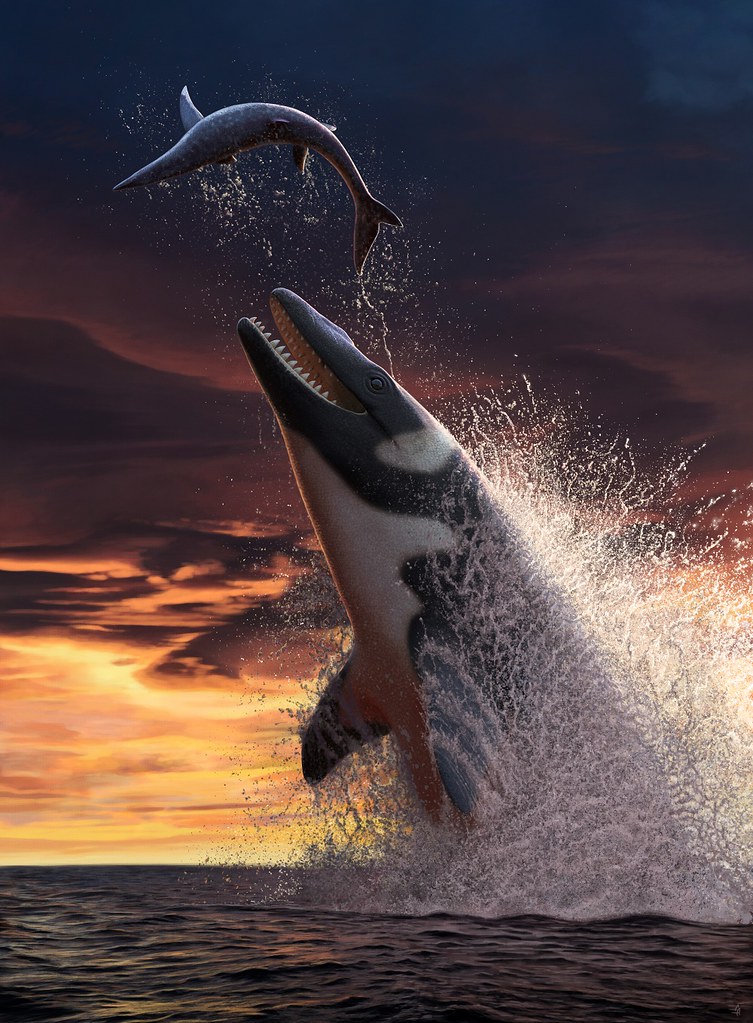
‘You get burnt together, you get wet together, you dance together’: how festivals transform lives – and landscapes
Amelie Katczynski, Deakin University; Elaine Stratford, University of Tasmania, and Pauline Marsh, University of TasmaniaEvery year in lutruwita/Tasmania, tens of thousands of people journey to and meander through the island state and take in festivals such as Dark Mofo, Cygnet Folk Festival or Nayri Niara Good Spirit Festival.
Part of the pull of this place and its cultural offerings are the landscapes in which such events are placed: picturesque mountain ranges and deep valleys; vast open paddocks and pristine bushlands; glistening coastlines; quirky city spaces.
As human geographers, we understand that festival landscapes are more than a party backdrop. They are not waiting, ready to greet us like some sort of environmental festival host. They have Deep Time and layers of meaning.
But when they become spaces for creative adventures, these landscapes also have profound effects on how people experience festivals, affecting our sense of place, of ourselves and others.
Festivals come with specific boundaries – dates, gates or fences – and mark a period and place in which we experience some shifting of social norms.
In our research, we wanted to explore how festivals affect people’s sense of place, self and other.
As Grace, an avid festival-goer, told us “social expectations that come with adulthood get removed at a festival.”
I don’t know what happens when you walk through the gate of a festival [..] you leave all that behind and you step into what feels like […] a more authentic version of yourself. Or at least a freer one.
Creating Spaces
A lot happens to make a festival landscape.

Teams of staff and volunteers establish campsites, install rows of toilets that often are also composting works of art, build stages, lay kilometres of pipes and power chords and design paths, sculptures and dance floors.
These collective labours create a special atmosphere; serve basic needs for sleep, food, hydration, warmth and sanitation; invite journeying to and from; and foster relationships to places and sites via immersive experiences and hands-on engagements with the landscape itself, for itself.
Travis, a stage-builder and DJ, told us:
if you use what’s already there, then [the stage] blends in with that whole environment and ties in to how people see it and how people feel in it.
Marion, a festival artist, spoke of her desire to show care and respect by creating work that “doesn’t impose and can […] naturally be reabsorbed” into the landscape.
She described how all of the rocks for a labyrinth at one event came from the festival site. Once, the sheep who lived there walked through on their usual path – destroying her installation.
Transformative Experiences
When people attend festivals, they often attach themselves to the landscape and detach from their daily lives: they are looking for transformative experiences.
In lutruwita/Tasmania, festivals such as Fractangular near Buckland and PANAMA in the Lone Star Valley take place in more remote parts of the state.
Grace, from Hobart, told us that being in those landscapes taps into
something that humans have done forever […] gather around sound and nature and just experience that and feel freedom.
Even when festivals are based in urban landscapes, the transformation of these spaces can evoke a sense of freedom.
For Ana, a festival organiser, creating thematic costumes is part of her own transformation.
At festivals she feels freedom to “wear ‘more out there’ things”.
If I was on the street just on a Wednesday I’d have to [explain my outfit] […] Whereas at a [street] festival[it] flies under the radar.
Body Memories
Festival landscapes have features conducive for meeting in place (think open spaces, play spaces, food and drink venues) and for separating out (think fences and signs).
Commingling at festivals can literally lead people to bump into each other, reaffirm old bonds and create new connections through shared experiences.
One artist, Marion, told us:
When you go and you camp, you get burnt together, you get wet together, you dance together. [It creates] an embrace for me.
Festivals often linger in people’s memories, entwined with bodily experiences. People we spoke with talked about hearing birdsong and music, seeing the sun rise and fall over the hills and feeling grass under their dancing feet.
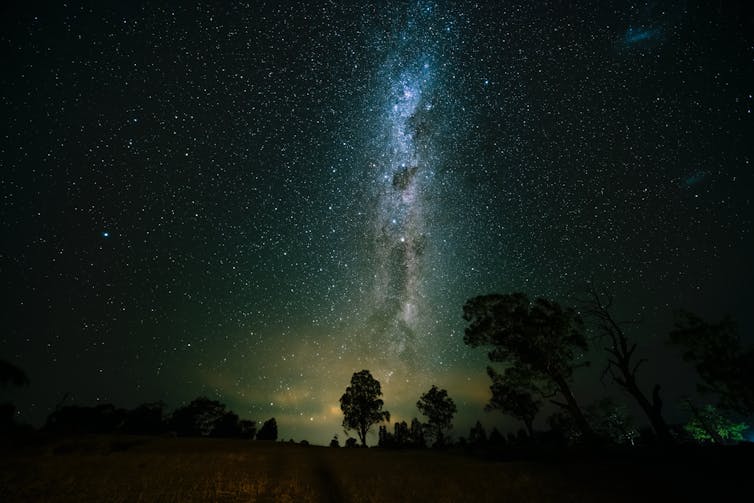
While one-off events can be meaningful, revisiting festivals may have an especially powerful effect.
Annual festival pilgrimages become cycles of anticipation, immersion and memory-making. This continuing relationship with a landscape also allows festival goers to observe how the environment is changing.
As festival organiser Lisa said:
since 2013 […] every summer our site just got drier and drier. 2020 was the driest year of all. There was no creek. There was just a stagnant puddle.
Writing New Stories
The COVID-19 pandemic led organisers and attendees to rethink engagements with live events. Many were cancelled; some were trialled online.
But after seasons of cancellations, downscaling and online events, some festivals in lutruwita/Tasmania are back, attracting thousands of domestic and interstate visitors.
For those festivals that have disappeared, their traces remain in our countless individual and collective stories of the magic of festival landscapes.![]()
Amelie Katczynski, Research Assistant, Deakin University; Elaine Stratford, Professor, School of Geography, Planning, and Spatial Sciences, University of Tasmania, and Pauline Marsh, Social Researcher, Wicking Dementia Research and Education Centre, University of Tasmania
This article is republished from The Conversation under a Creative Commons license. Read the original article.
Les Murray said his autism shaped his poetry – his late poems offer insights into his creative process

An autistic author recently tweeted:
I filled out an autism quotient questionnaire for my upcoming assessment and one of the questions was about if I am fascinated by dates and I said no BUT now I want to go to the supermarket and buy some dates and see how fascinating they really are.
Reading this, I decided that a personal reevaluation of dates was definitely in order, despite our previous incompatibilities.
For me, the first hurdle in even tolerating any food is the physical experience of eating it – its initial combination of textures, and how they change during the eating process. Like Les Murray’s son Alexander, I hated “orange juice with bits in it” throughout my childhood. I still dislike the bits, but I have learned to endure them for the taste, which is my process for at least half of what I eat.
My memory of the taste of dates when I tried them as a child is sugary dirt, so they were never worth their gluey gelatinousness. But perhaps they, or I, would be different now. Intrigued by this idea, I sent the “dates” tweet to my partner, who describes himself as “having more than a hint of neuroatypicality”. He replied that he had always thought that that question referred to going out to a romantic dinner.
Of course, the non-autistic designers of the autism quotient test intended “dates” to refer only to the day, month and year of an event.
Autism And Detail
These differences in word association are one reason that Les Murray identified autism as “the part of my brain […] which is mostly the part my poetry comes from”.
They also emphasise the role of context in interpretation. Though being autistic enabled the intimate relationship with detail and uncommon relationship with the world that are characteristic of Murray’s poetry, his autism often went unacknowledged when his poetry was interpreted.
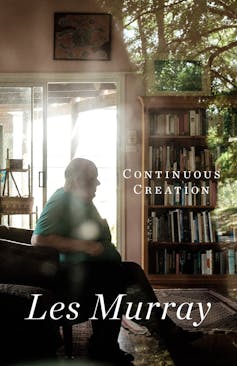
Having explored the influences of autism in Murray’s poetry for a number of years, I was intrigued that autism and recontextualisation were of particular interest to him in his final collection Continuous Creation, where they often intertwine.
While Murray explicitly foregrounds his autism, some of his intentions regarding context are unclear. One example of this uncertainty is the poem Cherry Soldiers, which appears at the halfway point of the book. Here it is, in its two-line entirety:
Chokecherry, chokecherry, makin a stand:
I got your little pokeberry eatin from my hand.
Caroline Overington labels this poem “fun”, which may well be the experience Murray intended it to convey as a singular poem in this collection. For me, however, it evokes the unease that I feel whenever I read it in Fredy Neptune.

Fredy Neptune was Murray’s second verse novel, published in 1998. It is the self-narrated story of an autistic German-Australian man named Fredy Boettcher.
Near the beginning of the novel, Fredy witnesses a mass murder that is part of the Armenian genocide, after which he acquires an impairment which includes the absence of physical sensation. Over the course of the novel, he develops an understanding of his impairments and negotiates others’ prejudices against him, in the midst of some key events in the first half of the 20th century.
The two lines of the poem Cherry Soldiers appear ten pages from the end of the novel. Fredy has settled in Australia with his wife, their adult son, and Hans, who is also autistic, and whom Fredy has adopted as his brother. In what I think of as a signal to anyone who has registered Fredy’s and Hans’s autism, they are at a train station, alleviating their stress by watching the trains arrive and depart.
They are separated by a group of American soldiers, one of whom draws Fredy into a conversation about names, while the rest begin teaching Hans to play poker. The reader is unsure what will occur next, until the captain of the troop returns and calls them to order. The soldiers sing “Chokecherry, chokecherry, makin’ a stand: / I got your little pokeberry eatin’ from my hand” as they leave.
Fredy finishes this story by noting his mixed emotions regarding this song: “Lord knows what that meant; but I still sing it sometimes.”
The Importance Of Context
The role of context is similarly both significant and mysterious for the poems School Bus Home and The Invention of Pigs. In his review of Continuous Creation, David McCooey cites these poems as new material and presents them as examples of Murray’s “inconsequential writing” and “love of the sonic nature of poetry”.
While I agree with McCooey about these perennial qualities of Murray’s writing, the two poems are not new writing, if you take “new” to mean not previously in existence. If you take new to mean not previously in this form, then they might be evidence of Murray’s skill at rearranging, because earlier versions of them appear in his book On Bunyah (2015).
The three stanzas of School Bus that appear in On Bunyah have been re-ordered, transposed from past to present tense, and supplemented with two additional stanzas to become School Bus Home in Continuous Creation.
The Invention of Pigs, which describes a bushfire moving through Bunyah, has the same title in both books, but there are alterations in all four stanzas that change the scope of the poem. For example, in On Bunyah, stanza three reads:
too swift to ignite any houses.
One horse baked in a tin shed.
After, a few pigs lay smoke-dead
but where flames had leaned in on
Whereas, in Continuous Creation, the pigs, even though they are named as the poem’s topic in the title, are deleted in favour of chickens:
too swift to ignite any houses.
One horse baked in a tin shed,
naked poultry lay about dead
having been plucked in mid flight
These are two of the three rearrangements of previous poems that I am aware of in Continuous Creation. The third has alterations similar to those in The Invention of Pigs and, like School Bus home, is told from a different perspective. The Scores, 20th Century was first published as The Scores in 2002. It is the only one of these four context-highlighting poems that is listed in the acknowledgements.
Evidently, Murray was not attempting to misrepresent these poems as originals, since they all have titles that reference their initial context. Beyond that, the future he imagined for them is unclear.
Perhaps he wanted Cherry Soldiers to be considered separately from, as well as within, its context in Fredy Neptune? Perhaps he had determined that the altered versions of School Bus Home and The Invention of Pigs should replace their earlier versions? Perhaps he assumed that those involved with the organisation and publication of Continuous Creation would be familiar enough with his work to get the joke, and exclude one or all of these poems?

Creation As Continuous
If Murray intended for these poems to be published, this represents a striking change in the presentation of his writing. Throughout most of his six-decade career, he continually adjusted his body of work to represent his current position on and in the world. Within this process, there was a connection between Murray of the past and Murray of the present that was stretched but not broken. When a break occurred, Murray deleted commas, lines, stanzas and entire poems to reestablish an alignment between his poetry as a whole and himself.
But I am unaware of rearrangement to this degree in his previous books. It might imply an interest in expanding from a conception of the process of creation as continuous to a conception of each individual creation as continuous.
There is further evidence for this in Waiting for the Past, which also originated in 2015 as a line in a poem. Murray used the line to title his other collection from that year. In Continuous Creation, Waiting for the Past is the title of a poem, and it has developed into a refrain on the subject of remembering.
Waiting for the Past describes how the many details of Murray’s “great memory”, which he noted when publicly declaring his autism in the poem The Tune on Your Mind (2006), have faded. Yet “flesh tells what mind forgets”.
In other words, perhaps in response to critics who have suggested that Murray should move on from long-ago arguments, this poem replies that with an autistic memory it is not so easy.
Another property of autistic minds is referred to in Polo Solved. Murray suggests that the absence of the Great Wall from Marco Polo’s extensive lists of what he observed during his 17 years in China was because:
if you are autistic
things that you’ve missed
seem not to exist.
This is a well-documented difference between non-autistic and autistic perception. Autistic author Star Ford calls them “forest-first” and “trees-first”, in order to value both approaches. Non-autistic people begin with an undifferentiated scene, then become aware of some details. Autistic people begin with one detail, and then add another and another, until they become aware of a scene.
This is one reason that autistic people might not notice details that seem obvious to non-autistic people, and vice versa. It is also the reason that Murray became the “delicately detailed describer of the earth” that, as Lyn McCredden notes, “even Murray-sceptics admire”.
Polo Solved is a reminder that Murray was autistic and it affirms that, to the end, autism was one of his strongest poetic themes. He first explicitly wrote on autism in Portrait of the Autist as a New World Driver in 1974. He continued writing poems on his own autism, such as Self-Portrait from a Photograph, The Shield-Scales of Heraldry, and The Tune on Your Mind. In Fredy Neptune, he explored the experience of being autistic before this way of being in the world was medicalised.
He also wrote poems on his son’s autism, including It Allows a Portrait in Line Scan at Fifteen, Like the Joy at his First Lie, and To One Outside the Culture.
As a part of his final collection, Polo Solved is a note on the role of context in “all that will outlast us”. For autistic writers, it is a reminder that Murray created, not just a path, but a field for us. It is a reminder for everyone to stay curious and to keep considering what you believe to be present, as well as what might be missing.![]()
Amanda Tink, PhD Candidate, Western Sydney University
This article is republished from The Conversation under a Creative Commons license. Read the original article.
Scientists have traced Earth’s path through the galaxy via tiny crystals found in the crust

“To see a world in a grain of sand”, the opening sentence of the poem by William Blake, is an oft-used phrase that also captures some of what geologists do.
We observe the composition of mineral grains, smaller than the width of a human hair. Then, we extrapolate the chemical processes they suggest to ponder the construction of our planet itself.
Now, we’ve taken that minute attention to new heights, connecting tiny grains to Earth’s place in the galactic environment.
Looking Out To The Universe
At an even larger scale, astrophysicists seek to understand the universe and our place in it. They use laws of physics to develop models that describe the orbits of astronomical objects.
Although we may think of the planet’s surface as something shaped by processes entirely within Earth itself, our planet has undoubtedly felt the effects of its cosmic environment. This includes periodic changes in Earth’s orbit, variations in the Sun’s output, gamma ray bursts, and of course meteorite impacts.
Just looking at the Moon and its pockmarked surface should remind us of that, given Earth is more than 80 times more massive than its grey satellite. In fact, recent work has pointed to the importance of meteorite impacts in the production of continental crust on Earth, helping to form buoyant “seeds” that floated on the outermost layer of our planet in its youth.
We and our international team of colleagues have now identified a rhythm in the production of this early continental crust, and the tempo points to a truly grand driving mechanism. This work has just been published in the journal Geology.

The Rhythm Of Crust Production On Earth
Many rocks on Earth form from molten or semi-molten magma. This magma is derived either directly from the mantle – the predominantly solid but slowly flowing layer below the planet’s crust – or from recooking even older bits of pre-existing crust. As liquid magma cools, it eventually freezes into solid rock.
Through this cooling process of magma crystallisation, mineral grains grow and can trap elements such as uranium that decay over time and produce a sort of stopwatch, recording their age. Not only that, but crystals can also trap other elements that track the composition of their parental magma, like how a surname might track a person’s family.
With these two pieces of information – age and composition – we can then reconstruct a timeline of crust production. Then, we can decode its main frequencies, using the mathematical wizardry of the Fourier transform. This tool basically decodes the frequency of events, much like unscrambling ingredients that have gone into the blender for a cake.
Our results from this approach suggest an approximate 200-million-year rhythm to crust production on the early Earth.
Our Place In The Cosmos
But there is another process with a similar rhythm. Our Solar System and the four spiral arms of the Milky Way are both spinning around the supermassive black hole at the galaxy’s centre, yet they are moving at different speeds.
The spiral arms orbit at 210 kilometres per second, while the Sun is speeding along at 240km per second, meaning our Solar System is surfing into and out of the galaxy’s arms. You can think of the spiral arms as dense regions that slow the passage of stars much like a traffic jam, which only clears further down the road (or through the arm).
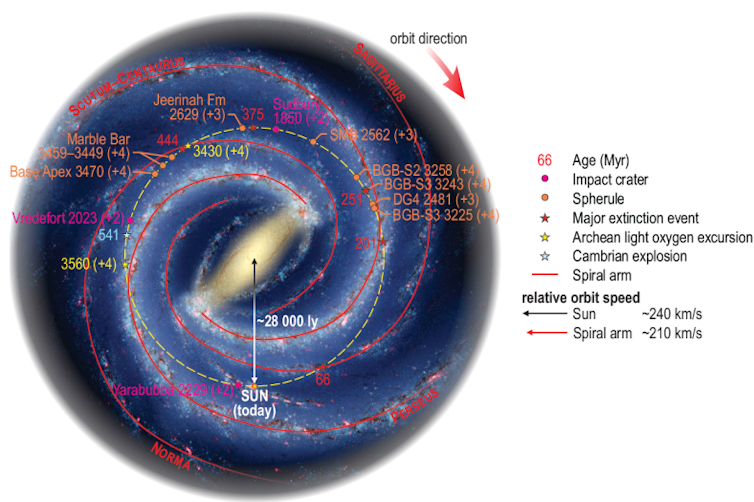
This model results in approximately 200 million years between each entry our Solar System makes into a spiral arm of the galaxy.
So, there seems to be a possible connection between the timing of crust production on Earth and the length of time it takes to orbit the galactic spiral arms – but why?
Strikes From The Cloud
In the distant reaches of our Solar System, a cloud of icy rocky debris named the Oort cloud is thought to orbit our Sun.
As the Solar System periodically moves into a spiral arm, interaction between it and the Oort cloud is proposed to dislodge material from the cloud, sending it closer to the inner Solar System. Some of this material may even strike Earth.

Earth experiences relatively frequent impacts from the rocky bodies of the asteroid belt, which on average arrive at speeds of 15km per second. But comets ejected from the Oort cloud arrive much faster, on average 52km per second.
We argue it is these periodic high-energy impacts that are tracked by the record of crust production preserved in tiny mineral grains. Comet impacts excavate huge volumes of Earth’s surface, leading to decompression melting of the mantle, not too dissimilar from popping a cork on a bottle of fizz.
This molten rock, enriched in light elements such as silicon, aluminium, sodium and potassium, effectively floats on the denser mantle. While there are many other ways to generate continental crust, it’s likely that impacting on our early planet formed buoyant seeds of crust. Magma produced from later geological processes would adhere to those early seeds.
Harbingers Of Doom, Or Gardeners For Terrestrial Life?
Continental crust is vital in most of Earth’s natural cycles – it interacts with water and oxygen, forming new weathered products, hosting most metals and biological carbon.
Large meteorite impacts are cataclysmic events that can obliterate life. Yet, impacts may very well have been key to the development of the continental crust we live on.
With the recent passage of interstellar asteroids through the Solar System, some have even gone so far as to suggest they ferried life across the cosmos.
However we came to be here, it is awe-inspiring on a clear night to look up at the sky and see the stars and the structure they trace, and then look down at your feet and feel the mineral grains, rock and continental crust below – all linked through a very grand rhythm indeed.![]()
Chris Kirkland, Professor of Geology, Curtin University and Phil Sutton, Senior Lecturer in Astrophysics, University of Lincoln
This article is republished from The Conversation under a Creative Commons license. Read the original article.
Breakthrough shows humans were already standing on their own two feet 7 million years ago
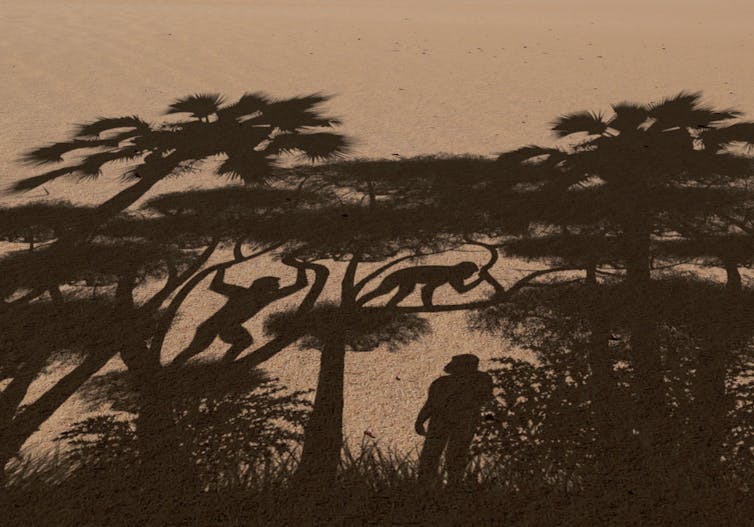
The study of present-day species has delivered a clear verdict on humanity’s place in the living world: right alongside chimpanzees and bonobos. However, this does not tell us much about our earliest human representatives, their biology or geographical distribution – in short, how we became human. For this, we mainly have to rely on the morphology of frustratingly rare fossils, given paleogenetic information is only preserved for recent periods – and even then, in rather cool climates.
Since the 1960s and the identification of the very early age of Australopithecus – including the famous Lucy aged 3.18 Ma (million years ago), discovered in 1974 in Ethiopia – the acquisition of bipedalism has been regarded as a decisive step in human evolution. Indeed, it is an essential feature that marks the transition from non-human to human long before the significant increase in the size of our brain.
There has been much anticipation of our study, published on 24 August in Nature, on the skeleton of Sahelanthropus tchadensis, who is a candidate for the oldest-known representative of humanity.
So, was our distant ancestor a biped or not – i.e., human or not human? In reality, asking the question in these terms borders on circular reasoning. Given we have yet to discover the last common ancestor we share with chimpanzees, we do not know the initial state of human locomotion – bipedal or otherwise.
Were The First Representatives Of Humanity Bipeds?
Until now, the earliest data available to us were the limb bones of Orrorin (6 Ma, Kenya) and Ardipithecus (5.8 Ma–4.2 Ma, Ethiopia), which practised a different type of bipedalism from that of more recent species. It turns out bipedalism is not an invariable feature of humanity and has its own history within our history. The right question is therefore: were the first representatives of humanity bipedal, and if so, to what extent and how? This is the question that our Franco-Chadian team sought to answer by studying the much older remains (about 7 Ma) of Sahelanthropus.
The existence of Sahelanthropus was initially deduced in 2002 from a distorted but otherwise well-preserved cranium (nicknamed Toumaï) and a few other cranio-dental specimens discovered by the Franco-Chadian palaeoanthropological mission (founded and directed by Michel Brunet) at Toros-Menalla in the Djourab Desert in Chad, representing at least three individuals. The study is primarily based on the morphology of the teeth, face and braincase that this species has been compared with more recent human fossils.
[More than 80,000 readers look to The Conversation France’s newsletter for expert insights into the world’s most pressing issues. Sign up now]
The limb bones described in our article include a partial left femur (thigh bone) and two left and right ulnae (together with the radius, the ulna is one of the two bones in the forearm that form our elbow). These bones were found in the same locality and year as the cranium, but were identified later in 2004. They most likely belong to the same species as the cranium, as only one large primate was identified out of nearly 13,800 fossils representing about 100 different vertebrates across 400 localities in Toros-Menalla. However, it is not known whether this femur, ulnae and cranium belong to the same individual, as at least three different individuals were found onsite.
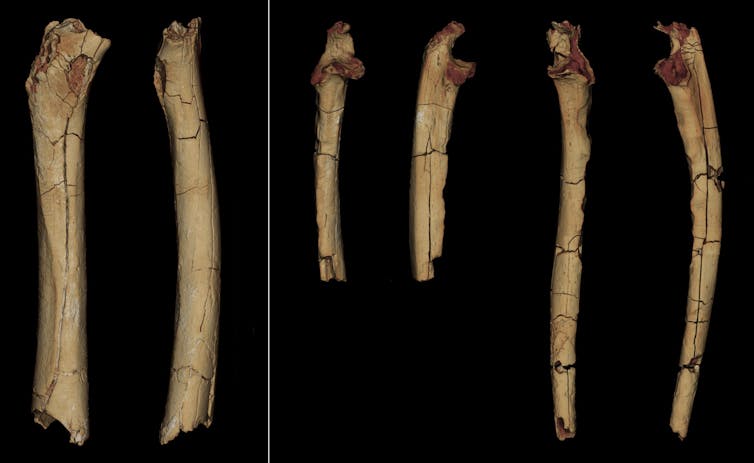
A number of factors slowed down our research, which began in 2004. For example, we were required to prioritise field research of other postcranial remains, while we struggled to analyse fragmentary material. We eventually relaunched the project in 2017 and concluded it five years later.
Bones Studied From Every Angle
Given the poor preservation of these long bones (the femur, for example, has lost both ends), brief analyses cannot provide reliable interpretations. We therefore studied them from all angles, both in terms of their external morphology and internal structures.
To reduce uncertainty, we employed an extensive set of methods, including direct observations and biometric measurements, 3D image analysis, shape analysis (morphometrics) and biomechanical indicators. We compared the Chadian material with present-day and fossil specimens through the prism of 23 criteria. Taken separately, none can be used to propose a categorical interpretation of the material – indeed, there are no “magic” traits in paleoanthropology, and all will be subject to discussion within the scientific community.
Taken together, however, these traits result in an interpretation of these fossils that is far more parsimonious than any alternative hypothesis. This combination therefore indicates that Sahelanthropus practised habitual bipedalism – i.e., that is as a regular means of locomotion. In this case, bipedalism was probably used for movement on the ground as well as in trees. In the latter case, it was most likely accompanied by a quadrupedal gait accompanied by the grasping of branches, in contrast from the quadrupedal gait practised by gorillas and chimpanzees, known as “knuckle walking”, in which weight is supported by the backs of the phalanges.
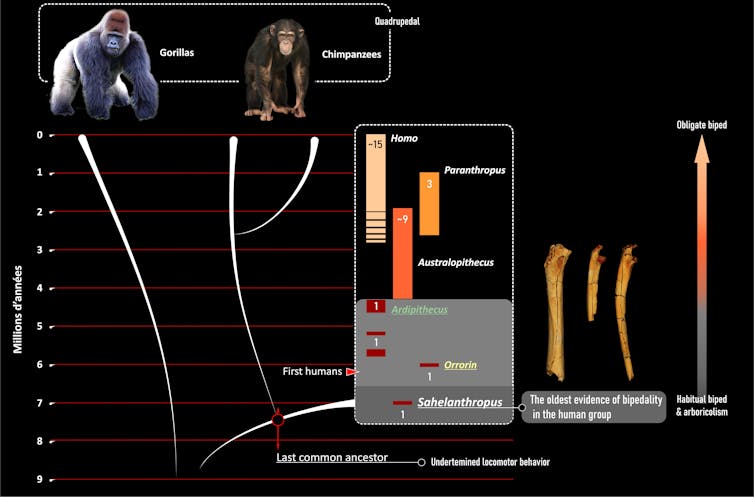
The results are consistent with observations made on Orrorin and Ardipithecus, and have several implications. First, they reinforce the concept of a very early form of bipedalism in human history coexisting with other modes of locomotion. Thus there was no “sudden” appearance of a characteristic unique to humanity right from the start, but a long, slow transition spanning millions of years.
This phase of human evolution thus took place in ways that are quite common throughout the history of life and the globe, and it reminds us that our species is but a fragment of biodiversity. This fact alone should lead us to rethink our attitude toward the living world and the parameters that govern the hospitality of our planet.
Second, the characteristics of Sahelanthropus, Orrorin and Ardipithecus suggest the ancestor we share with chimpanzees was neither chimpanzee-like nor the exclusive biped we have become. Contrary to the hypothesis that chimpanzees and bonobos retained their ancestral morphology, their particular combination of vertical climbing and “knuckle walking” more likely evolved well after our divergence.
Finally, if Sahelanthropus tchadensis is a witness of human diversity among others, it is, to this day, the only known habitual bipedal species of that age. Considering the whole, weakly diversified, hominoid fossil record of Africa and Eurasia at the end of the Miocene (after 10 Ma), the acquisition of bipedalism by the human branch on the African continent remains the only well-documented hypothesis to date. At this stage, the bipedalism appears to be part of an opportunistic locomotor repertoire – flexible, able to take advantage of different environments – that corresponds well to the diversified paleoenvironment of Toros-Menalla as reconstructed by the geologists, paleobotanists and paleontologists of our team.
This work was developed through a strong North-South scientific collaboration in palaeoanthropology, namely between the PALEVOPRIM laboratory, the palaeontology department of the University of N’Djaména and the Centre National de Recherche pour le Développement. These three bones belong to the Chadian heritage and will soon return to their country. At the same time, our fruitful collaboration will continue through new studies of the material as well as new field research that follows in the footsteps of the much-missed Yves Coppens, pioneer of paleontological research in Chad.
This article was co-authored by Abderamane Moussa (University of N’Djaména, Chad).![]()
Jean-Renaud Boisserie, Directeur de recherche au CNRS, paléontologue, Université de Poitiers; Andossa Likius, Mission Paléoanthropologique Franco-Tchadienne, Université de N'Djamena (Tchad); Clarisse Nekoulnang Djetounako, Enseignante chercheure en paléontologie, Université de N'Djamena (Tchad); Franck Guy, Paléoanthropologue, Université de Poitiers; Guillaume Daver, Maîtres de conférences en paléoanthropologie, Université de Poitiers; Laurent Pallas, Paléontologue, Kyoto University; Mackaye Hassane Taisso, Paléontologue, Université de N'Djamena (Tchad), and Patrick Vignaud, Pr. Paléontologie, Université de Poitiers
This article is republished from The Conversation under a Creative Commons license. Read the original article.
Establishment Of The Royal Commission Into Robodebt
- The establishment, design and implementation of the scheme; who was responsible for it; why they considered Robodebt necessary; and, any concerns raised regarding the legality and fairness;
- The handling of concerns raised about the scheme, including adverse decisions made by the Administrative Appeals Tribunal;
- The outcomes of the scheme, including the harm to vulnerable individuals and the total financial cost to government; and
- Measures needed to prevent similar failures in public administration.
Hold The Phone: You Don’t Have To Spend Big On A New One
National Head To Health Phone Service Goes Live
Suicide rates reveal the silent suffering of Australia’s ageing men

Men aged 85 and older have the highest suicide rates in Australia, but the tragedy has gone relatively unnoticed. This group is growing older, feeling alone and flying under the radar.
The tragedy of suicide is recognised as a major public health issue. Yet what may come as a surprise to many is data published by the Australian Bureau of Statistics showing men over 85 have suicide rates more than three times the average rate.
Public perception is that men – in particular, young men – have the highest suicide risk. While this is true for the net number of suicides, if we don’t consider age-standardised rates (which account for differences in age distribution across the population) we miss a crucial finding.
Adjusting For Age
Men aged over 85 accounted for a relatively small proportion of all male suicides (3.1%) in 2020 (the latest data available). But the age-specific suicide rate was 36.2 deaths per 100,000 (up from 32.3 per 100,000 in 2019). For women aged over 85, this rate was much lower (6.2 per 100,000). The next highest rate was for men in both the 40-44 and 50-54 age bands (27.1 per 100,000).
In 2020, the overall suicide rate was 12.1 per 100,000 people.
But this issue is rarely addressed in public discourse or policy directives. The National Study of Mental Health and Wellbeing released last month did not include data on people older than 85.
This risk is not new, but little has changed to address it over the past decade. In light of COVID and what it has revealed about ageism and the value of older people in our society, it is crucial to explore these issues again.

Preventable Deaths
It is startling that men who have shown resilience to survive to late life are at such risk of preventable death. Many factors contribute, including physical and material circumstances like frailty, chronic pain, bereavement and financial troubles. However, we cannot assume only external issues cause distress and lead to suicide.
In fact, for older people, successful ageing is rarely defined purely by physical circumstances. Ageing well often implies flourishing despite hardship.
The silent challenge among men aged over 85 who take their own lives is psychological and existential distress, which can reinforce feelings of loneliness and worthlessness. Older men at risk of suicide may feel they are “no longer needed” or perceive themselves as “burdensome” to family and community.
These beliefs can overlap with major life transitions, such as retirement, stopping driving or moving to residential care, where they are a minority. Such stressful events can increase feelings of marginalisation, loss of independence and worthlessness, and also lead to social isolation.
Talking About It
A reluctance to express their feelings or be vulnerable has long been discussed as an important factor for men’s wellbeing, especially when they’re feeling low.
Research suggests gender stereotypes and social norms linked to masculinity reduce help-seeking behaviours and can increase suicide risk. Many ageing men hold restrictive and stoic beliefs about what it means to be a man. This may make them less inclined to share when they aren’t coping.
Yet emerging research challenges the assumption men don’t talk because they can’t. One reason men are not talking about their mental health struggles is because there’s nowhere for them to open up in a way they see as culturally and socially acceptable.
Instead, older men are speaking through their actions.
Suicide prevention and early intervention responses that are not tailored to the needs of older men are unlikely to be effective. We need to meet men where they are and listen to their quiet and absent voices by designing programs in partnership with them.
This means better understanding men’s barriers to suicide interventions. These include a lack of trust in traditional services and an aversion to “formal” supports that frame emotional distress and suicidal behaviours as mental illness.
It also means exploring, developing and funding new options that are acceptable, relevant and accessible, such as gendered support, peer-led programs, community-based informal support and programs combining exercise with mental health promotion.
The objective is not only to develop more suitable suicide prevention for this specific group, but also to examine broader interactions between ageing, isolation and loneliness; all key risk factors for suicide that have become even more relevant due to COVID.
More Calls For Help
Increased feelings of distress and loneliness produced by the pandemic can be measured by increased calls to services such as Lifeline. And more persistent mental health problems are likely to present more slowly, over longer horizons, and peak after the most acute phases of the pandemic.
Older people have handled much of the burden of COVID, including unprecedented restrictions and ageist sentiments. We must recognise these factors – growing old, being alone and feeling unheard - underpin increasing distress felt by men aged over 85, not only during the pandemic, but more generally.
This group must be seen as a priority population for suicide prevention. We must start listening and work together to find solutions so older men can access the help they need in a way that suits them.
UNSW Ageing Futures Institute would like to acknowledge the research contribution of Lifeline Research Foundation’s Dr Anna Brooks (National Manager) and Dr Tara Hunt (Research and Engagement Manager).
If this article has raised issues for you, or if you’re concerned about someone you know, you can call these support services, 24 hours, 7 days:
Lifeline: 13 11 14
Suicide Call Back Service: 1300 659 467
Kids Helpline: 1800 551 800 (for people aged 5 to 25)
MensLine Australia: 1300 789 978
StandBy - Support After Suicide: 1300 727 24

Rhys Mantell, PhD Candidate, School of Population Health, UNSW Sydney and Adrienne Withall, Senior Research Fellow, School of Population Health, UNSW Sydney
This article is republished from The Conversation under a Creative Commons license. Read the original article.
Men's Sheds Grants And Movember Improving Men's Health
Celebrities Combine Forces And Voices To Support People Impacted By Dementia + National Dementia Helpline Now 24/7
Complaints, missing persons, assaults – contracting outside workers in aged care increases problems

Aged care homes struggling to meet staffing needs are increasingly relying on externally contracted care workers to make up shortfalls.
However, our new study, shows homes that rely more heavily on externally contracted care staff provide significantly worse quality of care.
With the government convening a national jobs and skills summit next week, much attention is focused on addressing current staff shortages across the economy. Legislation has just been passed to increase the numbers of workers in aged care homes, and our research indicates workers’ employment conditions are critical to ensuring higher quality of care is provided to senior Australians.
‘Agency’ Staff Across The Sector
Within the residential aged care sector, approximately 9% of all the registered nurses, enrolled nurses and personal care workers are external contractors. Employed by third-party labour hire agencies, these “agency” staff work across different aged care homes on a temporary basis.
This sort of employment arrangement can help homes deal with short-term fluctuations in demand and staffing shortfalls. So it’s not surprising that as shortages have become more acute, this workforce strategy has become more commonplace.
In particular, as homes have struggled to maintain sufficient staff during the COVID pandemic, the use of agency staff has increased across the sector.
As agency staff tend to work intermittently, there are concerns they lack familiarity with individual residents and their unique needs. This can be disruptive and distressing for residents and their families and undermine the continuity of their care.
Also, as agency staff frequently work across different homes, they tend to be less efficient and require more supervision. This can can increase workload pressures, stress and turnover of permanent workers.
The Relationship Between Staffing And Quality Care
Our study of 1,709 aged care homes over five years investigated the relationship between the quality of care provided by aged care homes and their reliance on agency contract care staff.
We found the use of agency staff was relatively common, with the majority of homes using agency care staff at some point.
More importantly, we found homes that rely more heavily on agency staff have worse quality of care. Specifically, they have higher rates of workforce-related complaints to the regulator, occurrences of missing residents, reportable assaults, preventable hospitalisations and instances of non-compliance with accreditation standards.
While this is the first such study in Australia, these results align with international evidence. One striking similarity is how sensitive care quality is to even tiny increments of agency staffing. We found that even if just 5% of care time is delivered by agency staff, homes deliver significantly poorer quality outcomes.

But We’re In The Middle Of A Workforce Crisis
Our findings suggest one way to improve quality of care is for homes to reduce their reliance on contract care staff. This could involve efforts to improve the recruitment, retention and rostering of permanent nurses and care workers.
However, in the current context, this might be easier said than done. With the industry in the midst of a massive workforce crisis, homes may have no choice but to continue to rely on agency workers.
In such cases, homes should adopt strategies to mitigate the potential for bad outcomes. For example, they might improve residents’ continuity of care by drawing from a pool of regular agency workers and investing in better orientation and shift handover processes.
In terms of policy, much of the recent reform agenda has focused improving staffing numbers and skills in aged care, through funding for training programs, mandatory care minutes, 24/7 registered nurses and addressing workers pay.
Another of Labor’s election promises was to implement a recommendation from the Royal Commission to require aged care providers to preference direct employment over using contracted “agency” workers. This issue is now being investigated by the Productivity Commission, which will hand its report down next month.
No Quick Fixes
Simply putting limits on agency staff is unlikely to work in the current context. Imposing caps may result in homes providing less total care to residents.
Rather, the widespread use of agency across the sector reflects a need to understand and address its root causes. As will be discussed next week at the jobs summit, staffing shortages are not isolated to aged care but widespread across the economy.
Policymakers also will have to be mindful of the impact of other reforms in play. For instance, the use of contractors may well increase as providers attempt to increase staffing levels to meet incoming mandatory minimum standards, while managing the demands and disruptions of COVID outbreaks.
Despite these challenges our research highlights the importance of finding ways to sustainably curb the use of contract staff so as to deliver the quality of care all senior Australians deserve.![]()
Nicole Sutton, Senior Lecturer in Accounting, University of Technology Sydney and Nelson Ma, Senior Lecturer, University of Technology Sydney
This article is republished from The Conversation under a Creative Commons license. Read the original article.
Overseas recruitment won’t solve Australia’s aged care worker crisis

Next week’s job summit will need to address the massive staff shortages in aged care. Estimates suggest 35,000 additional aged care workers per year are needed to fill growing aged care skill shortages. These problems will only increase as demand continues to grow.
Aged care workers provide personal and health care such as showering, feeding and changing dressings, help people with shopping and other community tasks, and support people in their homes and in aged care facilities.
As the recent royal commission into aged care found, after decades of poor planning and governance, particularly at the local and regional level, it’s now hard to attract workers.
Workers are poorly paid, with hourly wages starting at around A$22. They often work casually or part time and there are limited career pathways.
Only around 5% of providers are currently exceeding the target staffing levels the new government has promised for 2023. Not surprisingly, there is high staff turnover in the industry and many providers simply can’t get staff.
But while skilled migration can play a role in aged care, it’s unlikely to be enough to fix the immediate or long-term problems.
What Has The Government Done To Boost Workers So Far?
The new federal government has opened up the Pacific Australia Labour Mobility (PALM) scheme to bring in more aged care workers to plug the gap.
The PALM scheme allows eligible aged care providers to hire workers from nine Pacific islands and Timor-Leste for between one and four years in unskilled, low skilled and semi skilled positions when there are not enough local workers available.
Currently, there are about 27,000 PALM workersin Australia. Most are in agriculture and manufacturing. The federal government is committed to growing the scheme, but at the end of 2021 there were only about 150 PALM workers in the care sector.
Migration Processing Is Lagging
The total migration program is 160,000 visas per year. About 110,000 visas are for skilled migration. The rest is for families. The federal government has recently indicated it is looking at permanent migration for aged care workers.
Following COVID, there is a massive backlog in processing applications, resulting in a substantial reduction in migration.
The Department of Foreign Affairs and Trade handles skilled visa applications and the actual assessments are issued by one of 42 skills assessing authorities. A full skills assessment takes about four to six weeks. But it takes around six to nine months for the department to issue skills visas for permanent migration and longer for temporary migration.
The Department of Home Affairs has been directed to speed up visa processing and clear the substantial backlog that has built up during the last three years.
But Migration Numbers Are Unlikely To Meet Demand
Even if the backlog is addressed and processing times improve, it is unlikely there will be sufficient appropriately qualified applicants to meet the aged care shortages through skilled migration, given the high demand for workers across the board and the international shortage of health care workers.
There are also broader risks in relying on temporary migration to fix short-term problems. Temporary solutions have a nasty habit of becoming permanent and undermining labour market conditions. There is now a long history of temporary migration undercutting wages and workers’ rights.
So what can be done to attract and keep aged care workers?
5 Ways To Boost The Aged Care Workforce
1. Increase wages
Most importantly, wages for aged care workers must be improved immediately. The current work value case before the Fair Work Commission will help if the commission grants a substantial wage increase. The unions have called for a 25% lift to wages for aged care workers. That case should be determined later this year.
2. Improve conditions
Better wages alone won’t be enough. Conditions for aged care workers have to be made more secure. While consumer choice and flexibility are important, that can’t be at the expense of proper protections for workers. Aged care workers often have insecure and variable hours, split shifts and out-of-pocket costs.
3. Scale up training
Training and career structures have to be much more attractive. Around 30% of the workforce do not hold a relevant aged care qualification.
Despite the demand for improved training, the vocational education sector has difficulty attracting aged care students. Entry pathways to aged care work have to be made much more attractive.
While there are some traineeships for aged care, these could be scaled up. A national scaled up program of paid aged care traineeships should be considered to address the problem as an immediate extension of the federal government’s free TAFE initiative.
A Certificate III in Individual Support could be completed over two years with trainees working three days a week with approved home care and residential care providers. Training and supervision could be provided in partnership with TAFEs.
Paid traineeships would be attractive – and 10,000 to 15,000 traineeships would make a significant dent in the aged care workforce shortage.
The costs of aged care employment and training are already included in federal and state aged care and VET budgets. A traineeship scheme could be implemented in 2023.
4. Develop career structures so workers can progress
In the medium term, aged care career structures have to be reformed both to improve the quality of the management, supervision and care of aged care services and to develop and retain the aged care workforce.
The new government’s initiatives to require 24/7 nursing oversight in all residential care facilities and to increase the care time to be provided are a start, but a broader emphasis on restructuring the personal care workforce is also needed. In particular, all personal care staff should be required to have appropriate training and registration to work in aged care.
5. Make it more attractive
Finally, the attractiveness of working in a reformed aged care sector needs to be promoted. A compelling vision of a high quality, well run, properly funded aged care sector with good wages and conditions and career pathways is needed to make aged care a much more desirable career choice.![]()
Hal Swerissen, Emeritus Professor, La Trobe University
This article is republished from The Conversation under a Creative Commons license. Read the original article.
Former High Court judge Virginia Bell to investigate Morrison’s secret ministries

The government has appointed former High Court judge Virginia Bell to inquire into former Prime Minister Scott Morrison having himself secretly appointed to five ministries.
Bell will examine the facts and circumstances of what Morrison did and the implications of his actions.
She will also report in “the practices and policies which apply to ministerial appointments”, recommending procedural or legislative changes to give greater transparency and accountability.
Announcing the inquiry’s details, Prime Minister Anthony Albanese indicated how Bell conducted it would be basically up to her.
He expected those involved would co-operate but flagged that if they did not, the government would review the situation.
“We have every confidence that people will co-operate […] If there isn’t co-operation, then there are other matters that can be considered in the future.”
Asked about Morrison’s attendance, Albanese said it would be “extraordinary” if anyone refused to talk to a former High Court judge who was beyond reproach.
Bell will report by November 25, leaving time for parliament to deal with recommendations she makes.
During 2020-21, Morrison had himself appointed to the ministries of health; finance; industry, science, energy and resources; home affairs and treasury.
He did not tell cabinet of his multiple portfolios, and none of the appointments was publicly announced.
His moving into health was agreed to by the health minister, Greg Hunt. His appointment to resources was known to the minister concerned, Keith Pitt, whom Morrison overrode on an exploration matter, and to two Nationals leaders.
The other ministerial incursions were not known to the ministers in the portfolios. Morrison has said he did not exercise any powers in the portfolios except on the resources decision.
The solicitor-general found the appointments were legal but by keeping them secret, Morrison had breached the principle of responsible government.
“It is impossible for the Parliament and the public to hold ministers accountable for the proper administration of particular departments if the identity of the Ministers who have been appointed to administer those departments is not publicised,” the opinion said.
Asked whether the remit of the inquiry would expand as far as including the role of the governor-general, Albanese said: “The governor-general has made clear that his actions were upon the advice of the government, and that’s the focus of the inquiry. If you look at the terms of reference [… ] the governor-general has a particular place under our constitutional system.”
It will be a matter for Bell whether she seeks to question the governor-general.
The public will be able to make written submission to the inquiry, but there will not be public hearings.
Under her terms of reference, Bell will report on the implications arising from the Morrison appointments for not just the functioning of departments, but for government business enterprises and statutory bodies.
She will examine the implications for the structure of the ministry, the accountability of the executive to parliament and public confidence in government.
She will also examine the practices and processes applying to the appointment of ministers under section 64 of the constitution and directions that ministers hold certain offices under section 65, including the disclosure of appointments and directions.
Bell was appointed to the High Court in 2009 and retired in 2021.![]()
Michelle Grattan, Professorial Fellow, University of Canberra
This article is republished from The Conversation under a Creative Commons license. Read the original article.
Preparing Multicultural Communities For NSW Plastics Ban
- plastic straws, stirrers, cutlery, plates, bowls and cotton buds
- food ware and cups made from expanded polystyrene
- rinse-off personal care products containing plastic microbeads.
Mental Health Resources Become Accessible For Diverse Communities In NSW
NSW Government Builds On Housing Taskforce Response
- Delivering around 270 more homes for key frontline workers in the regions;
- Expanding the Urban Development Program to more high-growth regional areas, to improve infrastructure coordination and delivery;
- Improving data by auditing residential land, identifying infrastructure gaps and environmental constraints, to establish a clearer housing supply pipeline;
- Identifying opportunities to use suitable Crown land for social and affordable housing development;
- Working with local government to improve assessment timeframes for new housing through the Faster Local Assessment Grant program;
- Investigating the introduction of standardised planning pathways for certain types of temporary accommodation, to address spikes in housing demand; and
- Preparing Regional Housing Delivery Plans in targeted economic areas.
Ocean Cooling Over Millennia Led To Larger Fish
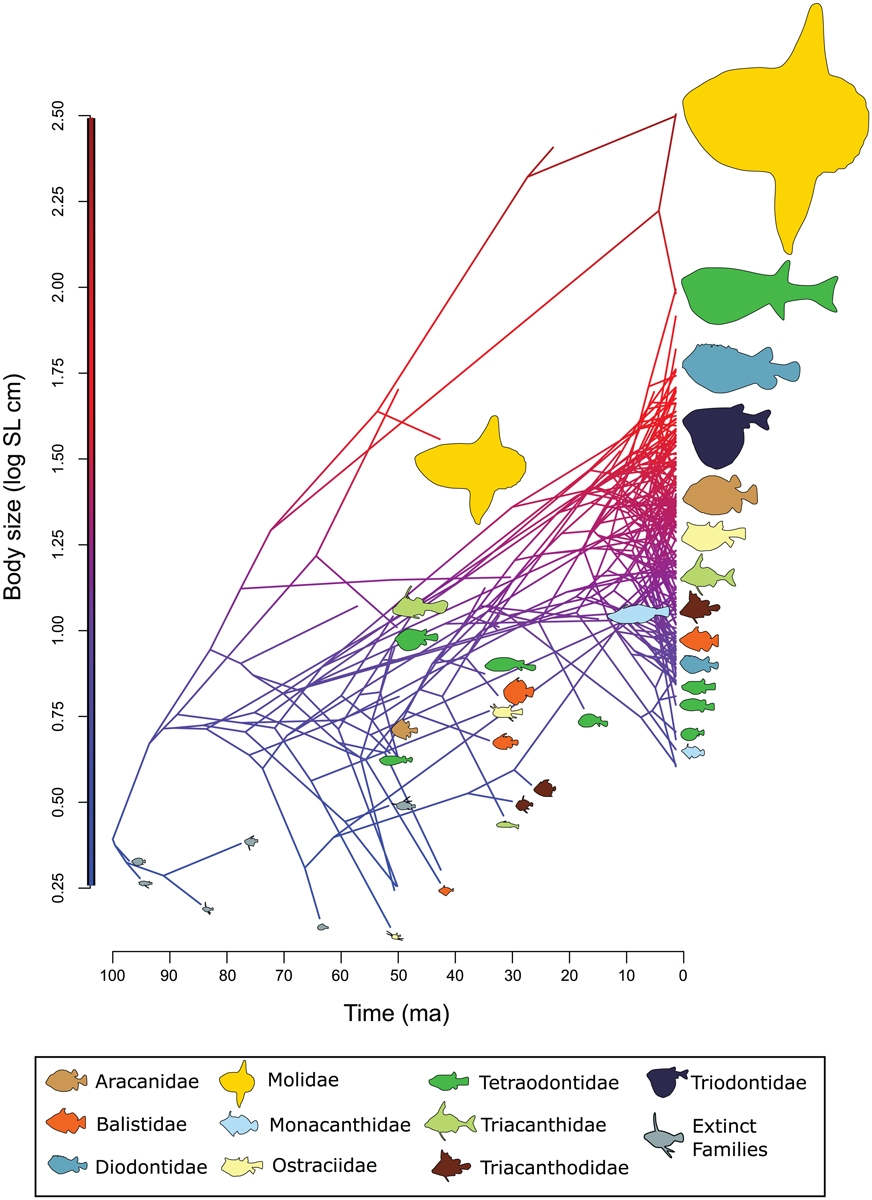
New Curtin Institute To Tackle The Transition To Sustainable Energy
Comet Impacts Formed Continents When Solar System Entered Arms Of Milky Way
Safeguarding Against 'Shadow Government' Appointments And Strengthening Australia's Democracy
Morrison’s multiple ministries legal but flouted principle of ‘responsible government’: solicitor-general
Michelle Grattan, University of CanberraScott Morrison’s action in having himself appointed secretly to multiple ministries was legal but breached “the principle of responsible government”, according to advice from the Solicitor-General, Stephen Donaghue.
Releasing the advice, Anthony Albanese announced the government would set up an inquiry, under an “eminent person with a legal background”, into the former prime minister’s actions.
Albanese said questions that needed examining included: “Why this occurred? How this occurred? Who knew about it occurring? What the implications are for our parliamentary system? Are there any legal implications behind decisions that were made? How can we avoid this happening again?”
Over 2020-21 Morrison had himself appointed to the ministries of health; finance; industry, science, energy and resources; home affairs and treasury. The appointments were not announced, Morrison did not tell cabinet and some of the ministers directly affected did not know.
The advice focused on the resources department, where Morrison overrode the decision of the minister on a gas exploration project, but the findings applied to the departments generally.
The solicitor-general said the constitution’s section 64 empowered the governor-general to appoint multiple ministers to administer a single department.
But under responsible government, outlined in chapter II of the constitution, the executive was responsible to parliament and, through it, to the electorate.
“It is impossible for the Parliament and the public to hold ministers accountable for the proper administration of particular departments if the identity of the Ministers who have been appointed to administer those departments is not publicised.”
Morrison’s multiple appointments were not announced and “there was no way the public could discern [them] from the Ministry list, or anywhere else.”
“The capacity of the public and the Parliament to ascertain which Ministers have been appointed to administer which departments is critical to the proper functioning of responsible government, because it is those appointments, when read together with the [administrative arrangements order], that determine the matters for which a Minister is legally and politically responsible.”
“To the extent that the public and the Parliament are not informed of appointments that have been made under s 64 of the Constitution, the principles of responsible government are fundamentally undermined.”
“Neither the people nor the Parliament can hold a Minister accountable for the exercise (or, just as importantly, for the non-exercise) of particular statutory powers if they are not aware that the Minister has those powers.”
“Nor can they hold the correct Ministers accountable for any other actions, or inactions, of departments.”
Morrison’s name did not appear in the ministry list in October 2021 in relation to any of the five departments he had been appointed to administer, the advice noted.
The solicitor-general said the undermining of responsible government did not depend on the extent to which Morrison exercised power.
Canvassing a number of ways the government could remedy the situation, including having all details put in ministry lists, the solicitor-general observed such measures would not bind future governments.
“For that reason, the Government might choose to entrench a requirement for the publication of appointments under s 64 of the Constitution by creating a statutory requirement for the publication of appointments”.
Albanese said he had told his department to work with the Office of the Official Secretary to the Governor-General to adopt a practice of publishing in the Commonwealth Gazette future appointments of ministers to administer departments. The government will also consider legislation to ensure such appointments are made public.
Governor-General David Hurley has come under public criticism for apparently not questioning the strange arrangement Morrison was making.
The solicitor-general noted, “The governor-general has no discretion to refuse to accept the prime minister’s advice in relation to such an appointment.”
Hurley himself has said he had no reason not to think the government would make the appointments public.
Albanese made it clear he would not criticise Hurley.
Asked whether Morrison should resign from parliament, Albanese said that is “a matter for Mr Morrison and his colleagues”.
“Quite clearly, I think Mr Morrison’s behaviour was extraordinary. It undermined our parliamentary democracy and he does need to be held accountable for it.”![]()
Michelle Grattan, Professorial Fellow, University of Canberra
This article is republished from The Conversation under a Creative Commons license. Read the original article.
Mysterious marks on boomerangs reveal a ‘forgotten’ use of this iconic Aboriginal multi-tool
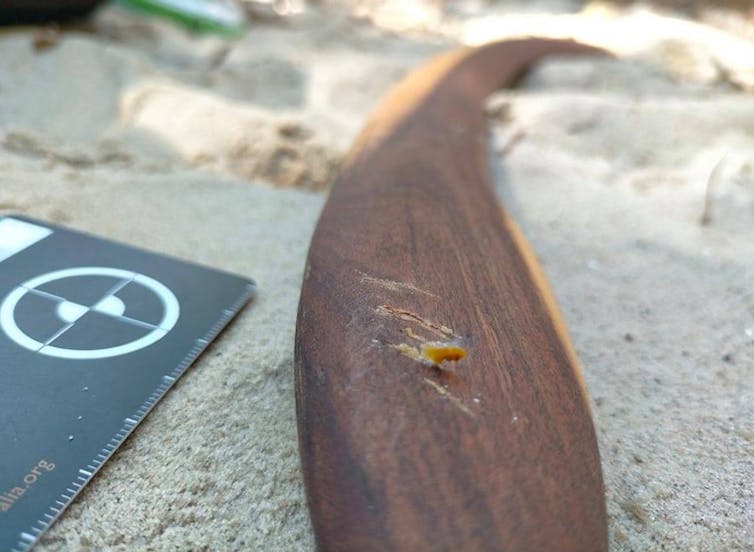
Alongside kangaroos and Akubra hats, boomerangs are one of the most iconic symbols of the Australian continent. They are also widely misrepresented.
Apart from hunting and fighting, boomerangs have many functions in the daily activities of Aboriginal communities, including digging, cutting, and making music.
These multiple functions are something Aboriginal people have always known, but the rest of the world has been none the wiser – until now.
In a recently published study in the journal PLOS One, we have “rediscovered” a function of boomerangs in Australian Aboriginal culture – shaping stone tools.
A Child’s Toy For A Tourist
Made from hardwoods, boomerangs are usually shown to return to your hand when thrown into the distance. This common depiction of the boomerang isn’t always true, however.
There is actually a variety of boomerang types, with the returning ones typically being children’s toys used for games and learning. (And, after European incursion, for selling to tourists.)
Most boomerangs are significantly larger than a child’s symmetrical, returning item – this increased size is required for their function as hunting and fighting weapons. But there’s an array of other functions, not all of them widely described in the literature.
We meshed Indigenous knowledge and experimental archaeology to produce scientific proof of a previously unrecognised (to science) use of these iconic objects: the manufacture of stone tools.
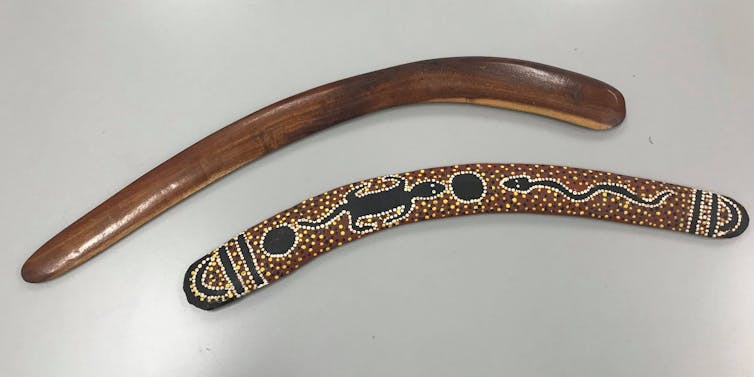
Nothing ‘Primitive’ About Working Stone
When we think about stone tools, we associate them with “primitive” technology. Nothing could be further from the truth.
Manufacturing stone tools requires an advanced understanding of fracture mechanics, extensive planning, and years of hands-on practice to produce even the most basic of tools.
Not unlike the contents of today’s kitchen drawers and garden sheds, human groups living in the deep past had access to an assortment of tools for all sorts of everyday activities.
The ability to carefully modify the edge of stone tools was crucial not only to produce the variety of utensils designed, but to resharpen them when they blunted. In modern terms, we can think about butcher knives and bread knives: their blades have different shapes – one straight, the other serrated – each used to effectively cut different materials.
Archaeologists call the careful shaping of a tool edge “retouching” – repeatedly touching (or working) the stone edge until it reaches the shape we want.
Wood Shapes Stone
For Australia, there is very little published evidence surrounding the retouching techniques used by various peoples across the continent. A deep dive into early European accounts of Aboriginal technologies suggested wooden tools – especially boomerangs – were used to shape their stone technology.
If true, this would be a retouching approach thus far unknown elsewhere in the world.
To investigate this idea, we designed an experiment to discover if boomerangs really could shape stone tools. Most archaeologists would have thought wooden items would not be suitable for such a tough task.
Expert hands infused with Aboriginal knowledge manufactured four hardwood boomerangs to be used in the experiment. These weapons were then put to repeatedly striking stone tool edges. During this process, small, thin pieces of stone detached from the edge – perfectly shaping the stone tool.
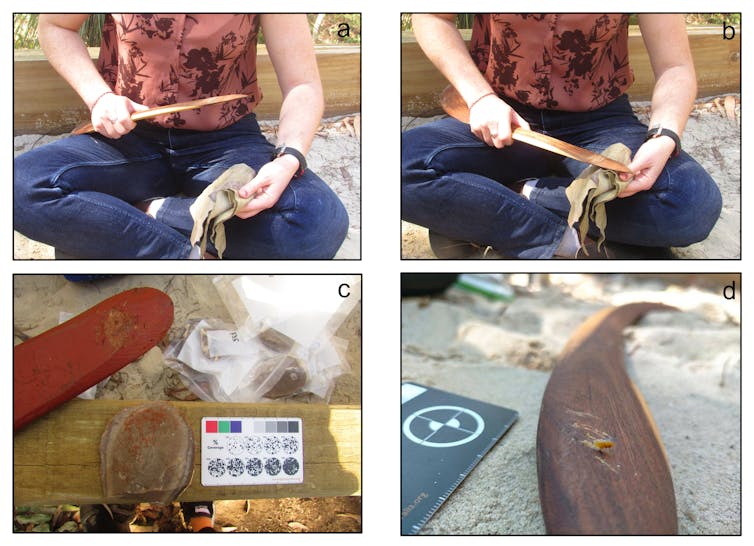
The impact of the sharp stone edge against the boomerang’s wooden surface left microscopic marks on the latter. Such marks are not new in archaeology. They have previously been found on bone fragments recovered from prehistoric archaeological sites in Europe dating back as far as roughly 500,000 years ago.
To document these marks, we used a powerful high-definition microscope to get a closer look. A great number of micro-flakes were found to have got stuck within the retouching marks – another trait in common with the bone tools from Europe.
These experimental results allowed us to identify distinctive marks on boomerangs curated by The Australian Museum in Sydney, some of them collected as far back as 1890.
Preserving A Diverse And Rich Past
Aboriginal and Torres Strait Islander Peoples across the country made and used hundreds of multifunctional utensils. Among these, the throwing stick known as “boomerang” sits high on the list.
Our work aims to join Indigenous knowledge and Western-based scientific investigation to explore Australia’s diverse and rich past. Sadly, with the passing of Elders, oral histories and ancient knowledge bases are being threatened.
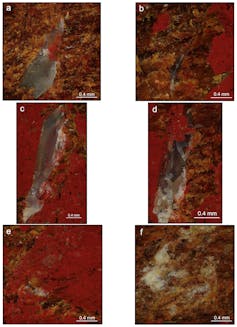
As communities join with archaeologists in examining artefacts, art, stories, songs, dances, languages, we can learn more about the past and the present. This process is empowering – discovering more about our past and our origins can only strengthen identity.
We are grateful to the Milan Dhiiyaan mob for sharing their Traditional knowledge and supplying bubarra/garrbaa/biyarr (boomerangs) representative of the cultural and spiritual beliefs of the Wailwaan and Yuin people.
The authors would like to acknowledge the contribution of study co-authors Dr Jayne Wilkins and Yinika L. Perston – who is also seen in the video using the boomerang to retouch the stone tools.![]()
Eva Francesca Martellotta, PhD candidate in Archaeology and Human Evolution, Griffith University; Michelle Langley, Senior Research Fellow, Griffith University, and Paul Craft, Owner Operator, Burragun Aboriginal Cultural Services, Indigenous Knowledge
This article is republished from The Conversation under a Creative Commons license. Read the original article.
Murdoch v Crikey highlights how Australia’s defamation laws protect the rich and powerful

There is no better example of how Australia’s defamation laws enable the rich and powerful to intimidate their critics than Lachlan Murdoch suing Crikey.com over a comment piece concerning Fox News, Donald Trump and the Washington insurrection of January 6 2021.
Crikey says it has published the correspondence between its lawyers and Murdoch’s in order to show how media power is abused in Australia.
The correspondence begins with a “concerns notice” Murdoch sent to Crikey, which is the essential first step in launching an action for defamation. In it, Murdoch claims that the Crikey commentary by Bernard Keane, published on June 29 2022, conveyed 14 meanings that were defamatory of Murdoch.
Murdoch’s Allegation And Crikey’s Defence
According to Murdoch’s claims, Keane’s piece alleges that Lachlan Murdoch illegally conspired with Donald Trump to overturn the 2020 US presidential election result and incite an armed mob to march on the Capitol to prevent the result from being confirmed.
Crikey has responded by disputing that these meanings are conveyed, saying they are “contrived and do not arise”. Crikey also argues that whatever it published could not possibly have done serious harm to Lachlan Murdoch’s reputation.
In order to get an action for defamation off the ground, Murdoch, the plaintiff in this case, has to satisfy the court that serious reputational harm has been done. The court may well decide this is the case.
Crikey says that given what much bigger media companies such as the Washington Post, the New York Times and the ABC (American Broadcasting Company) have already published about Murdoch’s Fox News and its propagation of the “Big Lie” that the 2020 presidential election had been stolen, what Crikey has published cannot further harm Murdoch’s reputation.
US Vs Australian Defamation Protections
This brings us to the first way Australia’s defamation laws facilitate intimidatory action by the rich and powerful.
Since those two big American newspapers have published similar material to that published by Crikey, the question naturally arises: why has Lachlan Murdoch not sued them? The answer is that in the United States, there is a “public figure” defence to defamation.
In the US, Lachlan Murdoch would easily qualify as a public figure, being executive chairman and CEO of Fox Corporation. If he sued there, he would have to prove malice on the part of the newspapers. That means he would have to prove that the newspapers lied or were recklessly indifferent to the truth.
No such defence is available to the media in Australia, despite decades of intermittent campaigning by the media that it is needed. The reasons these efforts have gone nowhere are twofold.

First, Australian politicians are among the most avid users of defamation laws, and it would be unrealistic to expect they would change this convenient state of affairs. This has been illustrated recently by the successful defamation action taken by the former deputy premier of NSW, John Barilaro, against an online satirist, Jordan Shanks, aka friendlyjordies.
Second, the tradition of accountability in public life is weak in Australia and the tradition of secrecy is strong, as vividly demonstrated by Scott Morrison’s behaviour in the affair of the multiple portfolios.
Another major factor in the chilling effect that the Australian defamation laws exert on the media is the extravagant damages the courts have awarded to plaintiffs that sue media companies, as well as the high cost of litigation. This has caused large media companies to settle cases even when they had an arguable prospect of defending themselves.
A recent example was when the biography of the AFL player Eddie Betts was published, confirming what had happened at the now notorious training camp held by the Adelaide Crows in 2018. At the camp, Betts alleged he was targeted, abused and the camp “misused personal and sensitive information.”
However, when The Age broke the story initially, it was sued by the company that ran the camp. The newspaper issued an apology, although it did not admit the story was wrong.
The Age said its parent company, Nine Entertainment, had made a “business decision” to settle the case. In other words, it did not want to risk the costs and damages involved in contesting the suit.
Liabilities For Online Publication
A third main factor is the failure of the Morrison administration to bring to finality stage two of the defamation law reforms, which concern the liabilities and defences for online publication.
Currently, anyone who publishes a website or a blog is liable for the comments made there by third parties. Continuously moderating comment streams for potentially defamatory material is onerous and expensive at a time when media organisations have far fewer resources than they did in the pre-digital age.
Against this backdrop, it is hardly surprising that Lachlan Murdoch feels he can use his immense wealth and power to intimidate and silence a relatively small outfit like Crikey.com. Behind him stand corporations with a market capitalisation of billions. Crikey says its company, Private Media, is valued at less than $20 million.
Murdoch’s Demands
Murdoch wants Crikey to take down the story and issue an apology. In pursuit of his case, he has filed suit in the Federal Court.
In defiance of Murdoch’s claim, Crikey has published his 2014 oration at the State Library of Victoria named in honour of his grandfather, Sir Keith Murdoch, as part of its publishing of the legal correspondence:
Censorship should be resisted in all its insidious forms. We should be vigilant of the gradual erosion of our freedom to know, to be informed and make reasoned decisions in our society and in our democracy. We must all take notice and, like Sir Keith, have the courage to act when those freedoms are threatened.
Quite.![]()
Denis Muller, Senior Research Fellow, Centre for Advancing Journalism, The University of Melbourne
This article is republished from The Conversation under a Creative Commons license. Read the original article.
Disclaimer: These articles are not intended to provide medical advice, diagnosis or treatment. Views expressed here do not necessarily reflect those of Pittwater Online News or its staff.